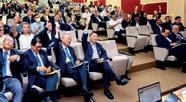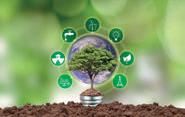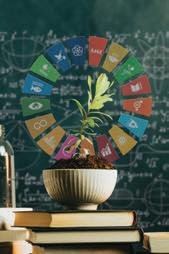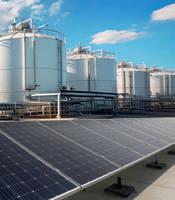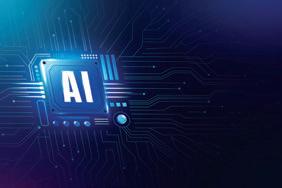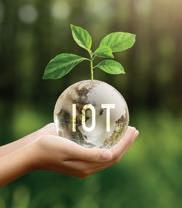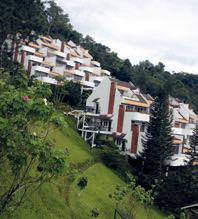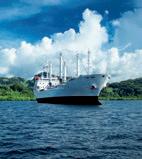



www.myiem.org.my






www.myiem.org.my


Circulation & Readership Profile
3,200/page
3,200/page
The publisher reserves the right to edit, revise or reject any advertisement deemed unsuitable or inappropriate. •
This one-time-only special rate o er is for new advertisers.
Space availability is subject to booking on a first-come-first-served basis.
Clients will provide ready-to-print artwork in PDF format with 300dpi.
Full page: 210mm x 297mm, 3mm extra bleed sizes for 4-sided.
Advertising space must be utilised before 31 December 2024.
*Please note that the above rate will be subjected to 8% SST. For overseas advertisers, an additional 25% will be charged.
Rate shown above excludes 15% advertising agency commission.
Payment term: Full advance payment.
Artwork submission deadline is on (or before) the 1st week of the prior month of publication.
After the material deadline, no cancellation or alteration to the advertisement will be entertained.
Any cancellation after signing the advertising order will result in a 50% penalty charge.
JURUTERA has an estimated readership of 200,000 professionals. Our esteemed readership consists of certified engineers, decision making corporate leaders, CEOs, government officials, project directors, entrepreneurs, project consultants, engineering consulting firms and companies involved with engineering products and services.
Publica�on month/s:
Company’s Stamp & Authorised Signature
Date


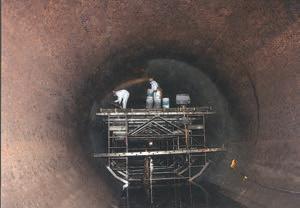
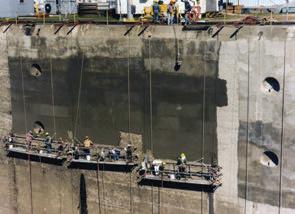
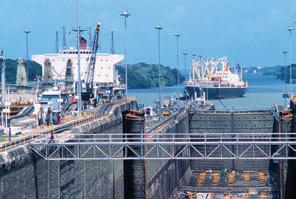
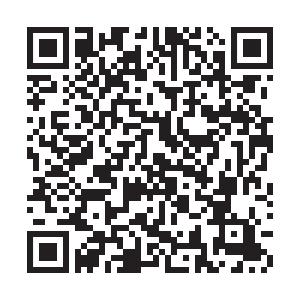



















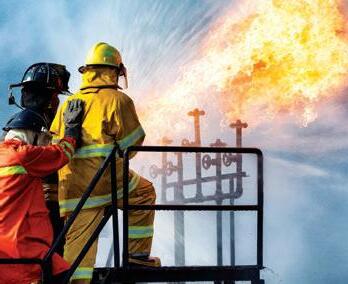
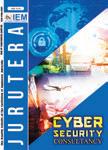

IEM COUNCIL SESSION 2024/2025
President
Ir. Prof. Dr Jeffrey Chiang Choong Luin
Deputy President
Ir. Yau Chau Fong
Vice Presidents
Ir. Dr Siti Hawa binti Hamzah, Ir. Fam Yew Hin, Ir. Chen Harn Shean, Ir. Ts. Prof. Dr David Chuah Joon Huang, Y.Bhg. Dato’ Ir. Wan Nazari bin Wan Jusoh, Ir. Dr Bernard Lim Kee Weng, YBhg. Dato’ Ir. Nor Hisham bin Mohd Ghazalli
Honorary Secretary
Ir. Ts. Prof. Dr Tan Chee Fai
Honorary Treasurer
Ir. Dr Siow Chun Lim
Immediate Past President
Dato’ Ir. Prof. Dr Norlida binti Buniyamin
Past Presidents
Y.Bhg. Academician Tan Sri Dato’ Seri Ir. Prof. Emeritus Dr Chuah Hean Teik, Y.Bhg. Dato’ Paduka Ir. (Dr) Hj. Keizrul bin Abdullah, Y.Bhg. Dato’ Ir. Lim Chow Hock, Ir. Dr Tan Yean Chin, Ir. Ong Ching Loon
Civil Representative
Ir. Tu Yong Eng
Mechanical Representative
Ir. Ng Yong Kong
Electrical Representative
Ir. Mohd. Aman bin Hj. Idris
Structural Representative
Ir. Dr Tan Kuang Leong
Chemical Representative
Ir. Kim Kek Seong
Representative to Other Disciplines
Ir. Assoc. Prof. Dr Wong Yew Hoong
ICT and Multimedia Representative
Ir. Assoc. Prof. Dr Lai Khin Wee
Women Engineers Representative
Ir. Ts. Assoc. Prof. Dr Syuhaida binti Ismail
Young Engineers Section Representatives
Mr. Muhammad Ashiq Marecan bin Hamid Marecan, Grad. IEM, Mr. Lim Yiren, Grad. IEM, Mr. Darshan a/l Balasubramaniam, Grad. IEM, Mr. Chuah Pei Lim, Grad. IEM, Ms. Ong Ye Shian, Grad. IEM
Council Members
Ir. Rusnida binti Talib, Ir. Prof. Dr Lau Hieng Ho, Ir. Muhammad Azmi bin Ayub, Ir. Arul Hisham bin Abdul Rahim, Ir. Razmahwata bin Mohd Razalli, Ir. Simon Yeong Chin Chow, Ir. Dr Chan Seong Phun, Ir. Yam Teong Sian, Ir. Kwok Yew Hoe, Ir. Dr Lee Choo Yong, Ir. Sharifah Azlina binti Raja Kamal Pasmah, Ir. Ts. Dr Wan Syakirah binti Wan Abdullah, Ir. Dr Mui Kai Yin, Ir. Shamil bin Abu Hassan, Ir. Ts. Wan Rizaluddin Abdullah bin Wan Ali, Ir. Dr Lam Wei Haur, Ir. Dr Angelia Liew San Chuin, Ir. Prof. Dr Zuhaina binti Zakaria, Ir. Begum Irdawati binti Dowlad Rahuman, Ir. Chong Chee Yen, Ir. Dr Khoo Chee Min, Ir. Abdul Razak bin Yakob, Ir. Dr Chan Swee Huat, Ir. Alex Looi Tink Huey, Ir. Sukhairul Nizam bin Abdul Razak, Y.Bhg. Dato’ Ir. Ting Chek Choon (casual vacancy for YBhg. Dato’ Ir. Nor Hisham bin Mohd Ghazalli)
Council Members by Invitation YBhg. Dato’ Ir. Ts. Abdul Razib bin Dawood, Ir. Gopal Narian Kutty, Ir. Oon Chee Kheng
Branch Chairman
1. Pulau Pinang: Ir. Chan Wah Cheong
2. Selatan: Ir. David Puen Ming Shen
3. Perak: Ir. Assoc. Prof. Dr Nursyarizal bin Mohd Nor 4. Pahang: Ir. Ab Rahman bin Hashim
5. Kedah-Perlis: Ir. Roshasmawi bin Abdul Wahab
6. Negeri Sembilan: Ir. Dr Oh Seong Por 7. Kelantan: Ir. Abrizan bin Abdul Kadir
8. Terengganu: Ir. Mazlan bin Che Ku Ahmad
9. Melaka: Ir. Lim Su Hian
10. Sarawak: Ir. Sim Hui Kheng, Stephanie
11. Sabah: Ir. Mohd Yaakob bin Jaafar
12. Miri: Ir. Meheron Selowara Joo
STANDING COMMITTEE ON INFORMATION AND PUBLICATIONS 2024/2025
Chairman: Ir. Fam Yew Hin
Vice Chairman: Ir. Alex Looi Tink Huey
Secretary: Ir. Ts. Assoc. Prof. Dr Hum Yan Chai
Chief Editor: Ir. Fam Yew Hin
Principal Bulletin Editor: Ir. Alex Looi Tink Huey
Principal Journal Editor: Ir. Ts. Prof. Dr Teo Fang Yenn
Chairman Webportal: Ir. Dr Hasril bin Hasini
Resource Centre Chairman: Ir. Razmahwata bin Mohd Razalli
Committee Members: Ir. Ong Guan Hock, Ir. Lee Chang Quan, Ir. Lau Tai Onn, Ir. Dr Oh Seong Por, Ir. Yee Thien Seng, Ir. Dr Lee Choo Yong, Ir. Ts. Dr Tan Kim Seah, Ir. Assoc. Prof. Dr Lee Tin Sin, Ir. Dr Bhuvendhraa Rudrusamy, Ir. Rusnida binti Talib, Ir. Dr Nor Ilia Anisa binti Aris, Ir. Ts. Wong Chee Fui, Ir. Dr Moey Lip Kean, Ir. Abdul Azim bin Abdul Rahman, Ir. Dr Aidil bin Chee Tahir, Ir. Kwok Yew Hoe, Ir. Begum Irdawati binti Dowlad Rahuman, Ir. Dr Sara Lee Kit Yee, Dr Sudharshan N. Raman, Grad. IEM, Ms. Michelle Lau Chui Chui, Grad. IEM, Mr. Chuah Pei Lim,Grad. IEM, Ms. Loo Suk Sin, Mr. Ng Han Wei
EDITORIAL BOARD 2024/2025
Chief Editor: Ir. Fam Yew Hin
Principal Bulletin Editor: Ir. Alex Looi Tink Huey
Committee Members: Ir. Lau Tai Onn, Ir. Ong Guan Hock, Ir. Yee Thien Seng, Ir. Dr Oh Seong Por, Ir. Ts. Prof. Dr Teo Fang Yenn, Ir. Razmahwata bin Mohd Razalli, Dr Sudharshan N. Raman, Ir. Lee Chang Quan, Ir. Dr Lee Choo Yong, Ir. Begum Irdawati bin Dowlad Rahuman, Ir. Ts. Dr Tan Kim Seah, Ms. Michelle Lau Chui Chui, Grad. IEM, Ir. Ahmad Rafidi bin Mohayiddin
THE INSTITUTION OF ENGINEERS, MALAYSIA
Bangunan Ingenieur, Lots 60 & 62, Jalan 52/4, P.O. Box 223, (Jalan Sultan), 46720 Petaling Jaya, Selangor Darul Ehsan.
Tel: 603-7890 0130 Fax: 603-7957 7678
E-mail: sec@iem.org.my Homepage: http://www.myiem.org.my
UPCOMING





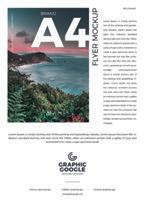



Annual Reports • Booklets • Brochures • Buntings • Business Cards
CD / DVD Replications • Calendars • Cards & Invitations • Certificates
Custom Printings • Envelopes • Folders • NCR Bill Books • Notepads
Leaflets • Letterheads • Paper Bags • Posters • Stickers • Others


DIMENSION PUBLISHING SDN. BHD. [ 199701034233 (449732-T) ]
Level 18-01, PJX-HM Shah Tower, No. 16A, Persiaran Barat, 46050 Petaling Jaya, Selangor Darul Ehsan, Malaysia. Tel: +(603) 7493 1049 Fax: +(603) 7493 1047
E-mail: info@dimensionpublishing.com Website: www.dimensionpublishing.com
CHAIRMAN
ROBERT MEBRUER
CEO/PUBLISHER
SHIRLEY THAM ● shirley@dimensionpublishing.com
HEAD OF MARKETING & BUSINESS DEVELOPMENT
JOSEPH HOW ● joseph@dimensionpublishing.com
PRODUCTION EDITOR
TAN BEE HONG ● bee@dimensionpublishing.com
CONTRIBUTING WRITERS
PUTRI ZANINA ● putri@dimensionpublishing.com
HANNA SHEIKH MOKHTAR ● hanna@dimensionpublishing.com
SENIOR GRAPHIC DESIGNER
SOFIA HANIS ● sofia@dimensionpublishing.com
GRAPHIC DESIGNER
NICOLE THENG ● nicole@dimensionpublishing.com
ADVERTISING CONSULTANTS
THAM CHOON KIT ● ckit@dimensionpublishing.com
ACCOUNTS CUM ADMIN EXECUTIVE
YEN YIN ● yenyin@dimensionpublishing.com
For advertisement placements and subscriptions, please contact:
DIMENSION PUBLISHING SDN. BHD. [ 199701034233 (449732-T) ]
Level 18-01, PJX-HM Shah Tower, No.16A, Persiaran Barat, 46050 Petaling Jaya, Selangor Darul Ehsan, Malaysia.
Tel: +(603) 7493 1049 Fax: +(603) 7493 1047
E-mail: info@dimensionpublishing.com
Subscription Department E-mail: info@dimensionpublishing.com
JURUTERA is published and printed monthly by Dimension Publishing Sdn. Bhd.
JURUTERA MONTHLY CIRCULATION: OVER 50,000 MEMBERS
Submission or placement of articles in JURUTERA could be made to the:Chief Editor THE INSTITUTION OF ENGINEERS, MALAYSIA (IEM) Bangunan Ingenieur, Lots 60 & 62, Jalan 52/4, P.O. Box 223 (Jalan Sultan), 46720 Petaling Jaya, Selangor. Tel: +(603) 7890 0130 Fax: +(603) 7957 7678
E-mail: pub@iem.org.my IEM Website: http://www.myiem.org.my
© 2024, The Institution of Engineers, Malaysia (IEM) and Dimension Publishing Sdn. Bhd.
PUBLICATION DISCLAIMER
The publication has been compiled by both IEM and Dimension with great care and they disclaim any duty to investigate any products, process, services, designs and the like which may be described in this publication. The appearance of any information in this publication does not necessarily constitute endorsement by IEM and Dimension. There is no guarantee that the information in this publication is free from errors. IEM and Dimension do not necessarily agree with the statement or the opinion expresssed in this publication.
COPYRIGHT
JURUTERA Bulletin of IEM is the official magazine of The Institution of Engineers, Malaysia (IEM) and is published by Dimension Publishing Sdn. Bhd. The Institution and the Publisher retain the copyright over all materials published in the magazine.
by Ir. Lee Chang Quan Chairman, Oil, Gas & Mining Technical Division

Mining activities started in Malaysia more than 150 years ago, slowly and on small scale, excavating for tin and sometimes gold. With the growing population and economic growth, small settlements near the mines soon developed into towns and trading, plantation, factories, logistics and ports flourished.
Mining not only created the variety of economic activities but it also attracted technology that was new to this land at the time, such as hydraulic pumps, steam engines, generators, locomotives and the power grid, just to name a few. Many pioneer engineers also ventured out from mining activities to contribute to infrastructure development. When mining activities declined in recent decades, engineers with skills and knowledge in mining, continued their work in quarries, infrastructure construction, irrigation and oil & gas engineering activities. In view of the escalating prices of minerals such as tin and gold and the interest in rare earth elements mining as well as the potential of remaining minerals deposits, engineering skills will need a rethink and reboot if Malaysia is to venture into mining as one of the new economic growth areas.
In this context, the Oil, Gas & Mining Technical Division (OGMTD) would like to bring about greater awareness through JURUTERA, discussions with academics and practitioners (one of the featured interviewees this month is both an engineer and an ex-miner!) of challenges in the revitalisation of the mining industry in Malaysia. We hope this will generate new ideas to spark a constructive development in the future of mining industry in Malaysia.
by Ir. Alex Looi Tink Huey Principal Bulletin Editor

As 2024 draws to a close, we dig deep – literally and figuratively – into one of Malaysia’s oldest industries: Mining. This month’s theme, Challenges in Revitalising the Malaysian Mining Industry, puts the spotlight on this long-standing sector and its quest for a sustainable, tech-forward resurgence. So how do we bridge the gap between tradition and technology to bring environmental consciousness to an industry known for its heavy footprint?
In this issue of JURUTERA , we explore innovative approaches that Malaysian engineers are championing to transform mining and to strike a balance between yield and sustainability as well as economics and ecology. With just one month left in the year, the push to rethink mining isn’t just a goal… it’s a necessity for a future-ready Malaysia. Here’s to wrapping up 2024 with new ideas, bold moves and a commitment to revitalise our resources responsibly.
Let’s unearth some fresh perspectives!

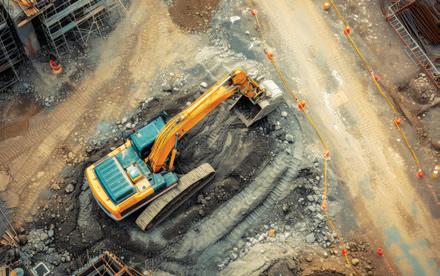
Interviewee:
Ir. Yap Keam Min, Ex-miner
In 1985, the tin mining industry in Malaysia was severely hit when tin ore prices fell by almost 50% overnight! The depleting resource of tin mining land also added to the problem. Within a decade, most of the country’s tin mines were closed. Malaysia (and formerly Malaya) had been a top producer of tin ore for decades, contributing to half of the total world production; we are still among the top refined tin producers in the world! The industry was in the doldrums for over 40 years and it was a huge problem to try and revitalise the sleeping giant.
Tin miners (meaning the owners and investors, not the workers) had moved on to other industries and many had retired. Most of the large tin mining companies changed their businesses and those listed on the KLSE were sold as shell companies.
Tin mining had always been a “high returns, high risk” venture. It is often said that one needs capital and guts to venture into tin mining. Today, it will require more capital and new technology to open a new tin mine.
Only workable grades of tin should be mined using the most efficient mining methods. The main issue though, is to identify land rich in tin ore.
Tin is the metal of the future and demand is continuously increasing because it is a main material of use in this digital age of AI, computers, handphones and plays a big role in batteries. The price of tin will surely
go up in the future as many modern products cannot be made without it, according to the International Tin Association, UK.
What critical technical skills and expertise are required to revitalise local tin mines and how does the current deficiency in these areas impact the industry?
The key skills are people, for hydraulic tin mining. (Please note that lode or primary mining is more technical and is not covered here!)
1. The mining engineer. Preferably with experience in tin mining including preparation of mining schemes, the position of the palong and sizes of the tailing ponds, source of water, mining lease approval, location of the tin ore bearing earth and control of tin mining operation according to governance.
2. The kepala or head man: This is the most important manager in a tin mine, especially in alluvial mining. The kepala has the knowledge and skills in all the practical aspects of running a tin mine, such as the design and construction of the palong, water and drainage control, safety of tin mines especially land subsidence, tin ore dressing and, of course, locating the tin ore.
3. The exploration team. Modern mining methods may require constant checking or searching for tin ore deposits.
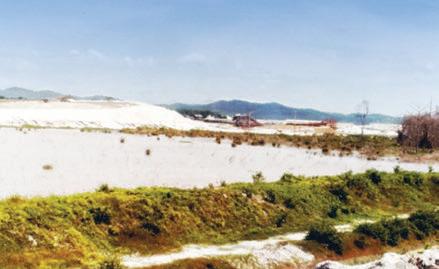


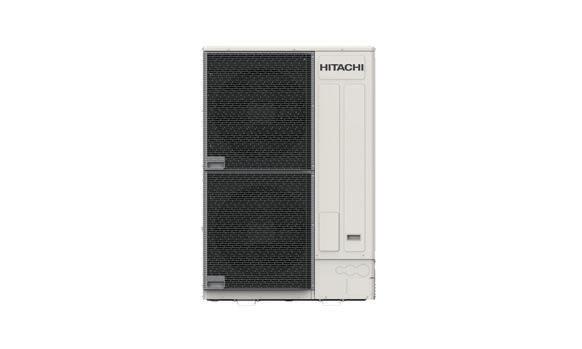



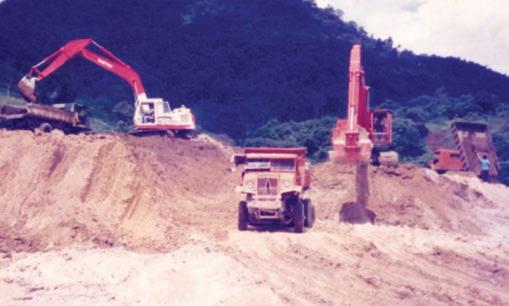
4. Tin ore processor or dressers. This team processes material bearing raw tin ore obtained from the palong or jigs into high concentration tin ore. The process may involve crushing and grinding, floatation method with jigs and shaking tables, magnetic separator, drying and packing. There is premium for efficiency as the purer the ore, the higher the price.
How do mining companies identify and assess the skill gaps within their workforce and what strategies are being implemented to attract, develop and retain technical professionals in key roles?
Workers and mining equipment such as pipes, gravel and water pumps can still be found in Perak as the state used to be the centre of tin mining activities in the world. Although mining activities have slowed down in recent decades, there are still many sand mines. The operations of a sand mine are somewhat similar to that of a tin mine, except for the process to recover the tin ore. In my opinion, the most important man is the kepala and if you can get a good and experienced kepala, he can assemble the necessary workforce.
What innovative approaches or initiatives have been rolled out to address the shortage of skilled workers and technical professionals in the tin mining sector?
There is no initiative at the moment. Maybe some day as tin is the metal of the future, one that the world cannot do without!
How do advancements in technology (automation and digitalisation) impact the skills requirements of the local mining workforce? What training and upskilling programmes are required to adapt to the changes?
This is a difficult question. It is like the chicken-and-egg story! However, I feel that at present, the tin mining activity in Malaysia is too small to talk about digitalisation.

In the past, the slurry containing tin ore is pumped up the palong
What can the industry do to foster a conducive working environment and to promote career advancement opportunities to overcome manpower challenges?
Unfortunately, the industry is still in the infancy stages of re-mining and there are so many uncertainties where mining profitability is concerned. The main issue is the location of land with rich deposits of tin; most of this land is state land.
Are there any collaborative efforts between mining companies, government agencies, academic institutions and other stakeholders to face the challenges related to the lack of a skilled workforce and technical professionals in the revitalisation of the tin mining industry?
At present, tin mining activity is very lethargic, so I doubt that government agencies are looking to collaborate in such efforts!

Ir. Yap Keam Min
An experienced tin miner whose family has been in the tin mining industry since the 1950s, Ir. Yap Keam Min is a professional civil and structural engineer who graduated from University of Southampton in 1976. He is a fellow of IEM, the Institution of Engineers UK and the Institution of Engineers Australia. He is also a Professional Engineer (PE), C.Eng., C.Eng. (Aust). Ir. Yap was the CEO/technical director of a large tin mine in Puchong from 1980 to 1983. His responsibilities included exploration/production of tin ore, drainage and tailings control as well as safety of the mine. From 1983 to 1985, he managed another tin mine in Chenderiang, Perak.
How do environmental, social and governance (ESG) concerns influence the strategies for revitalising the local mining sector?
Traditionally, mining and environmental concerns do not mix well! ESG is a relatively new concept here and in the past, most tin mining companies were not keen on the idea. There should be guidelines introduced as well as incentives to encourage compliance. In the past, mining activities often caused social problems with the community.
However, the good news is that ESG is possible in tin mining. Recently, the New Zealand Resources Minster was quoted as saying that “mining is no longer a dirty word. Mining equals jobs, regional development, export growth and economic prosperity for the country”, in reference to the gold mining activities coming on stream in that country.
Do sustainability issues impact the revitalisation of the mining industry? What steps are being taken to improve the sustainability of mining projects?
Sustainability is another new word for tin miners. Historically, tin mining caused pollution, silting of rivers and ex-mining tailing ponds with slime or soft clay made the land expensive to rehabilitate.
One new mining method which is sustainable and good for the environment is backfilling mining. Here, the mined areas are continually back filled as mining progresses. With more exploration, only workable or tin ore rich land will be mined and this will reduce the volume of tailings waste.
One benefit of tin mining is that it provides sand for the construction industry; today, sand has become more expensive and more difficult to obtain. There have been success stories of rehabilitated ex-mining land which have been turned into housing estates or golf courses. Some ex-mining land in Perak have even been turned into successful oil palm estates. However, these do not benefit the miners.
Assuming that Malaysia will invest heavily in tin mining if it is projected to be highly feasible economically in 5 years’ time, what skills or technical knowledge do we need to start nurturing now so that engineers can contribute to the new growth? This is a tough question! There is minimum incentive to train engineers for future possible growth!
At the peak of tin mining, the Camborne School of Mines (CSM) provided many mining engineers (probably 70% or most of the mining engineers I know) for the industry. CSM is the famous mining education centre in Cornwall, England, where commercial tin mining probably started and many mining companies, including the government, sponsored students to study there.
New methods of tin mining have to be efficient, sustainable and yet environmentally friendly. As the largest producer, China has many new and advanced mining equipment and techniques.
However, I believe if rich deposits of tin are found, skills and technology will not be a big issue.

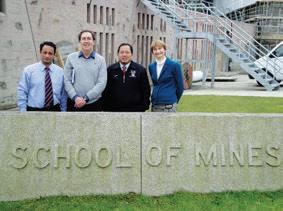
Interviewee:
Ir. Assoc. Prof. Dr Syed Fuad Saiyid Hashim
School of Material & Mineral Resources Engineering, Universiti Sains Malaysia (USM)

Trends for students doing mining-related courses in Malaysia are shaped by a combination of economic conditions, government policies, environmental concerns, technological advancements, educational opportunities and regional demand for minerals. These factors collectively influence the attractiveness of mining engineering as a career path for young Malaysians.
What are the key reasons for the lack of a skilled mining workforce and technical professionals in the country?
How can institutions of higher learning and technical vocational programmes address the specific technical skill requirements of the mining sector? What improvements can be made to narrow the gap between academic curricula and industry demands? We can do the following.
• Update Educational Programmes. Revise and modernise miningrelated curriculum to incorporate the latest technologies and industry practices.
What are the recent trends with concerns to students and miningrelated courses? What do you think are the reasons behind this (either increasing or decreasing)?
Enrolment in mining-related courses has been declining, not only in Malaysia but also globally. The younger generation considers mining as “archaic and dirty work” and feels it destroys the planet. They may not even be aware that there are mining engineering courses. Students enrolling in college know less about mining engineering than they do about other engineering majors and most are not interested in subjects they know little about.
The key reasons are limited specialised programmes and courses in mining engineering and related fields, leading to fewer graduates with the necessary skills. Insufficient opportunities for continuous professional development and training in new technologies and practices can exacerbate the skills gap. Limited hands-on training opportunities with limited duration through internship and apprenticeship can contribute to the lack of practical skills among graduates. Limited collaboration between the mining industry and educational institutions also results in graduates who are not well-prepared for industry needs.
• Enhance Industry Perception. Promote the importance of the mining industry and highlight opportunities available, emphasising advancements in sustainable practices.
• Government Support. Implement supportive policies, incentives and funding for mining education and training programmes.
• Continuous Training & Development. Provide ongoing professional development and training opportunities to keep the workforce updated on the latest skills and technologies.
• Strengthen Industry-Academia Collaboration. Foster partnerships between the mining industry and educational institutions to ensure educational programmes align with industry needs.
• Improve Work Conditions. Enhance health & safety standards and improve working conditions to make a career in mining more attractive.
Will technology transfer and knowledge exchange play a role in enhancing the technical capabilities of the mining workforce? How can industry collaboration assist in the acquisition of specialised skills and expertise?
Technology transfer and knowledge exchange can significantly enhance the technical capabilities of the mining workforce by introducing advanced technologies such as automation and AI as well as promoting best practices through training programmes, workshops and seminars.
Industry collaboration plays a crucial role in this process by partnering with educational institutions to develop relevant curricula, offering internship and apprenticeship for
hands-on experiences and facilitating continuous professional development and mentorship. Joint ventures, public-private partnerships and participation in global knowledge networks provide access to resources, expertise and the latest technological advancements, thereby addressing skill gaps and improving operational efficiency in the Malaysian mining sector.
Do academic institutions have continuous courses or professional development programmes for the mining workforce to upgrade skills and remain updated on the latest technologies?
Yes, many academic institutions offer continuous courses and professional development programmes for the mining workforce to upgrade their skills and stay updated on the latest industry technologies. These include short-term certificate programmes, professional development courses,
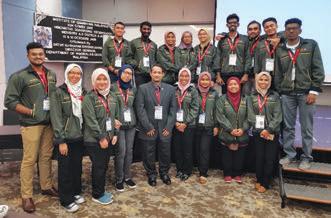
Industrial visits to mines and attending conferences abroad can further enhance the confidence and soft skills of students

online learning platforms as well as workshops and seminars. Institutions also collaborate with the industry to create customised training programmes and offer part-time and executive Master’s programmes as well as research opportunities. Universities and institutions such as Universiti Sains Malaysia (USM), Institute of Quarrying Malaysia (IQM) and Human Resource Development Corporation (HRD Corp) provide various programmes to ensure professionals remain competitive and informed on technological advancements. But these are limited and can be further enhanced.
Are current policies and regulatory impacts on the reforms streamlined with talent acquisition and recruitment?
Reforms in policies and regulatory framework are essential to streamline talent acquisition and recruitment in the mining industry. Key reforms should focus on addressing skills gaps through aligned educational programmes and continuous training, ensuring regulatory stability to attract investments and expedite permitting processes, promoting sustainable mining practices with strong environmental and social responsibility frameworks, fostering collaboration between industry and academia for curriculum enhancement and research, facilitating labour mobility through flexible immigration policies and providing financial incentives to support capacity building and industry growth.
These reforms aim to create a conducive environment for a skilled and sustainable mining workforce while supporting economic development and environmental stewardship.
What current research is there to manage perception challenges related to environmental impact and safety concerns and how can this contribute to promoting an understanding of sustainable mining practices, environmental stewardship and safety measures?
Current research is increasingly directed towards addressing the complex perceptions surrounding environmental impact and safety concerns by promoting sustainable practices, environmental stewardship and enhanced safety measures. One key area of focus is the development and implementation of green mining technologies, which emphasise the use of renewable energy sources, the reduction of greenhouse gas emissions and the adoption of ecofriendly extraction processes. Efforts in water management are paramount, with innovations in water recycling and treatment technologies aimed at minimising usage and preventing contamination.
Land rehabilitation practices are also evolving, with significant research dedicated to soil remediation and reforestation techniques which restore mined land to natural or improved states. The industry is also investing in advanced monitoring systems and impact assessments to predict and mitigate environmental impacts proactively. Safety measures are being revolutionised through the automation of hazardous tasks and the application of virtual and augmented reality for training purposes.
Promoting the understanding and acceptance of these practices involves active community engagement, transparent communication and the inclusion of local communities in decision-making processes.

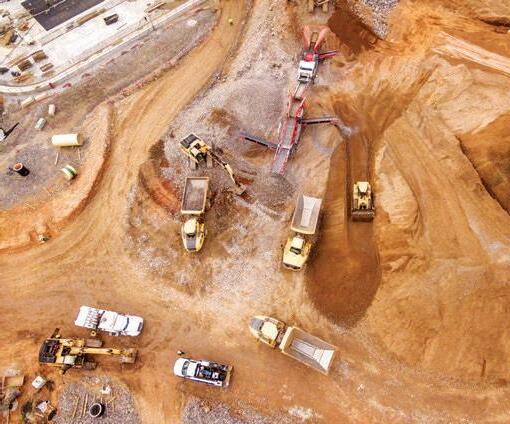
Educational programmes are being developed to inform the public about sustainable mining practices and the importance of environmental stewardship.
Through these efforts, the mining industry aims to reshape public perceptions by building trust, demonstrating transparency & accountability and positioning itself as a forward-thinking, responsible sector. These initiatives not only meet global mineral demands but also
Ir. Assoc. Prof. Dr Syed Fuad Saiyid Hashim
A senior lecturer in the School of Material & Mineral Resources Engineering, Universiti Sains Malaysia (USM). He graduated in B.Eng. (Hons) Mineral Resources Engineering from USM in 1996 and obtained his PhD in Minerals Engineering from University of Queensland, Australia in 2004. His research interests are in mathematical modelling of mineral processing system, mining and resources recycling. He is President of the Institute of Mineral Engineering Malaysia (IME) as well as a member of IEM and Society of Mining Professors.
significantly minimise environmental impacts and enhance the safety of the workforce, thereby promoting a more sustainable and responsible approach to mining.
How can IEM assist academic institutions in addressing the lack of a skilled workforce and technical professional challenges in the revitalisation of the Malaysian mining sector?
Engineering institutions can help by collaborating with academic institutions on developing industryrelevant curricula, offering hands-on training and organising workshops and certifications. They can support joint research projects, provide funding and facilitate industryacademia partnerships by involving experts as guest lecturers and mentors. Additionally, they can promote structured internship programmes, organise technical competitions and launch awareness campaigns about career opportunities to ensure students are trained in the latest technologies and are prepared for the industry demands.

Our business partners can be assured that their products and services will be given the circula�on and exposure they deserve, thus maintaining a sustained adver�sing presence to our core readers of decision-making engineers and technical experts. Our website offers an even wider market reach, with added interna�onal presence, aided by our interna�onal affilia�on with official engineering bodies all over the world.
Our online and offline adver�sing features such as banner adver�sing, ar�cle sponsorship and direct e-mail announcements have proven to be successful marke�ng strategies that will set the businesses of our partners apart from their compe��on.


















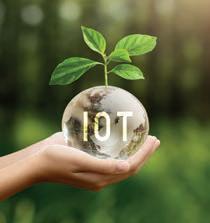
Circulation of over 50,000 among certified members of IEM














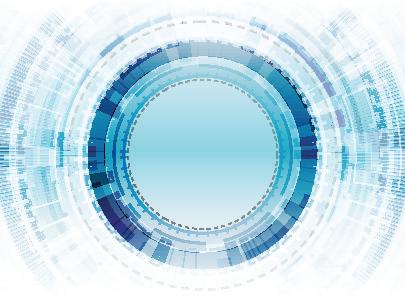

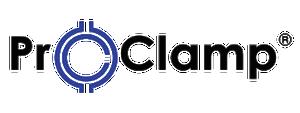
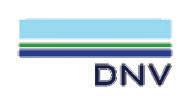
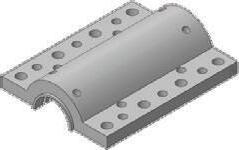

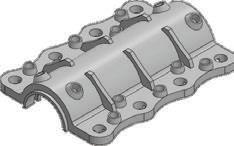
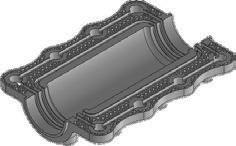
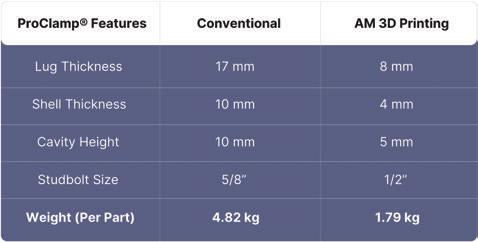

www.iosv.com.my
Specializing in pipeline rehabilitation and corrosion prevention since 1996.
Extends pipeline/ equipment service life and reducing maintenance cost.
Light weight and cost effective repair solution, live repair with no shutdown required.
Pipeline Integrity is essential in ensuring safe and reliable transport of hydrocarbons and other critical materials. With pipelines being exposed to harsh environmental conditions and operational stress, maintaining their integrity becomes challenging. This article discusses the common pipeline integrity issues and solutions using composite wrapping for pipeline repairs and rehabilitation. This can also serve as a valuable example of industry case studies demonstrating the effectiveness of composite wrapping solutions and pipeline integrity strategies.
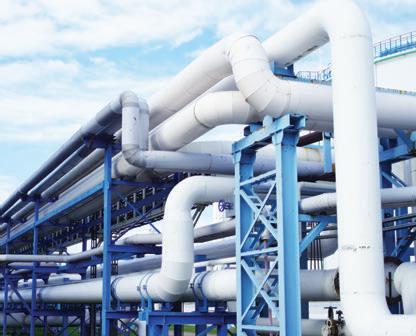
Pipeline systems are the backbone of the oil, gas and water industries. These systems, however, are constantly exposed to factors such as corrosion, external damage and environmental stress, which compromise their structural integrity. Ensuring the reliability and longevity of pipelines is essential to avoiding leaks, failures, and significant operational risks.
Maintaining pipeline integrity typically involves regular inspection, pressure monitoring, and repair of damages. Historically, maintaining pipeline integrity involved traditional repair techniques such as welding, clamping, or steel sleeves. While effective, these methods can be time-consuming, costly, and labor intensive. Over the past few decades, the advent of advanced materials has revolutionized the pipeline repair industry. One of the most promising materials is composite wrapping. Composite wrapping has emerged as a cost-effective and durable alternative for pipeline repair and rehabilitation. ASME PCC-2 Part 4 and ISO 24817:2017 are the international standard design code for composite wrapping.
iWrap® is a composite wrapping system developed by IO Setia Ventures Sdn. Bhd. (IOSV), showcasing advanced engineering and materials science. This innovative system integrates several key elements, all of which have undergone rigorous qualification testing to ensure optimal performance and reliability.
iWrap® materials utilized glass fiber reinforcements embedded in a thermoset polymer matrix. This combination not only enhances the structural integrity of the repaired components but also provides excellent resistance to environmental factors and mechanical stresses.
Table 1 - iWrap® product range
Series
iWrap® UW
iWrap® 100N
iWrap® HT200
iWrap® HT400
IOSV was called to rehabilitate a buried 24” hydrocarbon pipeline with severe dent defect due to environmental induced stresses (soil subsidence). The dented pipeline section was identified using a camera crawler and confirmed upon excavation. The pipeline owner was concerned on the potential leak and catastrophic failure if left unattended. A total of five defect locations were identified, each exhibiting varying defect sizes and characteristics. This defect is categorized as Type A (NonLeak) defect where the defect is within the substrate, not through-wall and not expected to become through-wall within the repair design lifetime of the repair system, thus requiring structure reinforcement only.
Based on the analysis of these defects, repair design calculations according to ISO24817:2017 were performed to determine the repair parameters, specifically the minimum repair laminate thickness, t min and the axial length of repair. These calculations are crucial in ensuring the integrity of the pipeline is restored effectively.
According to the ISO 24817: 2017 – 7.5.4.2 Limited by allowable strain in the repair laminate. For buried pipeline, the repair is applied at zero internal pressure, plive = 0 where the formula used for minimum repair laminate thickness follows Formula 7, and the formula for total axial length of repair, l is given by Formula 20, .


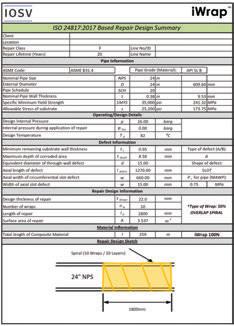
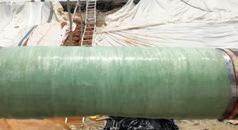
IOSV had successfully applied composite wrapping system iWrap® 100N to strengthen and restore the integrity of the pipeline. Material recovery compound (MRC) was applied to the defect area prior to the composite wrapping application to restore the pipe circular shape, enhances adhesion bonding between the repair material and the substrate, improves the load transfer, bond strength and overall integrity of the composite wrapping repair. This is to ensure the repair system performs as intended under operational and environmental loads.
The primary inspection method for composite wrapping is visual inspection, which is conducted post-installation to assess the overall condition of the applied composite material. This method allows for the immediate identification of any visible defects, such as surface irregularities, improper bonding, or signs of delamination.
Once the composite wrapping has cured at the desired temperature, a Hardness test (Shore D) is commonly conducted to measure the hardness of the composite wrapping material. This test confirms the cured composite laminate has achieved the desired mechanical strength and durability.
Another NDT method used to detect delamination within the composite wrap is the Coin tap test. This method involves striking the surface of the cured composite laminate with a lightweight object, such as coin, to listen for variations in sound. Areas of delamination or voids will produce a hollow sound compared to the solid, crips sound emitted by well-bonded sections.
Advance non-destructive testing NDT shall be performed to determine the integrity of the composite wrapping upon finding of abnormalities, determined by the nature and severity of the defects. Microwave, laser shearography, dynamic respond spectroscopy (DRS), computed radiography testing (CRT) and several other NDT methods can also be used to check integrity of composite-substrate.
Composite wrapping is highly effective for pipeline repairs and rehabilitation. It offers a cost-effective solution, fast turn-around without hot-work, excellent material strength and durability. Composite wrapping proved to be an effective choice for repairing and rehabilitating pipelines.



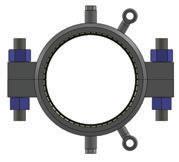
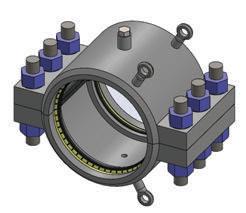
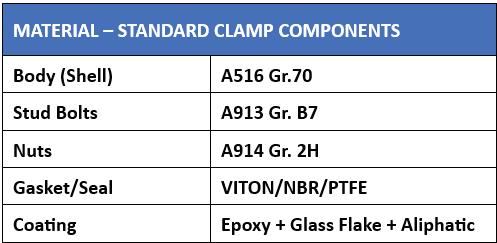
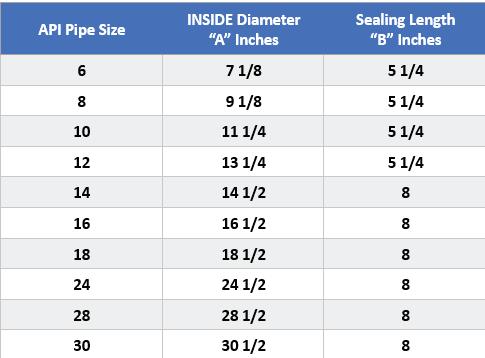
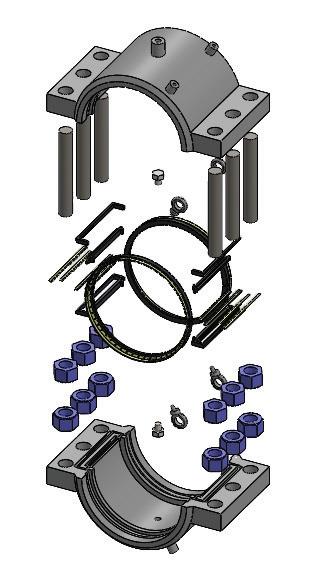
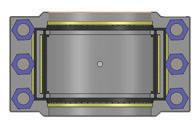
Mineral resources engineering is a multidisciplinary field encompassing geology, mining, mineral processing and environmental management. It combines scientific knowledge, engineering principles and sustainable practices to ensure the responsible and efficient utilisation of mineral resources while minimising the environmental impact.
Mineral resources engineers play a pivotal role in meeting the growing global demand for raw materials required for various applications. However, this field has faced a growing shortage of skilled professionals in recent years. This shortage threatens the ability to meet increasing global demands for essential minerals, which are crucial for a wide range of applications, from renewable energy and clean technologies to electronics, construction materials and various industrial processes. Without a sufficient pipeline of skilled professionals, the minerals and mining industries struggle to keep up with the growing need for such critical raw materials which underpin modern society and the transition to a sustainable future.
The declining number of graduates in these fields is one of the primary factors behind the current shortage of skilled professionals. In the past decade, enrolments have declined significantly, resulting in fewer graduates entering the industry. The decline can be attributed to several contributing factors. One of these is perception: Mining is often perceived as dirty, dangerous and environmentally destructive. This negative image, influenced by outdated practices and incidents in the past, discourages potential students. Many still view mining as an industry of the past rather than as a forward-looking sector with exciting opportunities, such as developing automated mining systems, using renewable energy in operations and implementing eco-friendly mining techniques.
The other contributing factors include the lack of awareness about the diverse and rewarding career paths in mining, as well as the cyclical nature of the industry. All these give rise to job insecurity concerns among students. Many students and their families are unaware of the technological advancements and sustainability initiatives that have transformed modern mining and
Prepared by:

Ts. Dr Ku Esyra Hani Ku Ishak Lecturer in USM School of Materials & Mineral Resources Engineering and chairperson of Strategic Mineral Niche Research Group.
mineral processing practices. This lack of awareness extends to educational institutions, where minerals and mining engineering is not promoted as viable and exciting career paths. For example, many secondary school career advisors are not familiar with the diverse career opportunities in the minerals and mining industry, so they steer students towards more well-known engineering fields such as civil or mechanical engineering.
In addition, university career fairs and recruitment events often do not prioritise the presence of minerals and mining companies, leaving students unaware of the potential to pursue a career in this sector. The absence of active promotions and the visibility of mining engineering as a rewarding career choice also contributes to the continued lack of awareness.
Another contributing factor is the outdated curricula in many academic programmes. Many minerals and mining engineering programmes have not kept pace with the rapid technological advancements and changing industry needs. For example, the curricula do not adequately cover topics such as automation, data analytics and sustainable mining techniques that have become increasingly important in modern industries.
The lack of hands-on training with the latest technologies and software used in the field can also create a disconnect between what students learn and the skills that employers seek. This gap between academic training and industry requirements can discourage students from pursuing these programmes, as they feel unprepared for the realities of the modern mining workplace.
The industry’s ability to innovate and improve productivity is directly tied to the availability of skilled engineers and technicians. Mining companies struggle to fill critical roles, resulting in operational challenges and increased reliance on less experienced workers, which can compromise safety, productivity and overall operational efficiency. This shortage also puts additional pressure on existing staff, leading to burnout and higher turnover rates. Furthermore, the scarcity of qualified professionals drives up labour costs as companies compete to attract and retain talent, impacting the profitability of mining operations and the affordability of raw materials. Higher labour costs reduce the competitive edge for mining companies, especially in global markets.
Collectively, these factors discourage new entrants and contribute to the ongoing decline of workers in this vital industry.
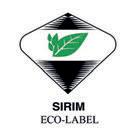
A multifaceted approach is required to address the human capital crisis in this field. A critical first step is to rebrand the industry. Efforts should be made to rebrand the industry, emphasising its role in driving technological innovation and sustainability. Highlighting the contributions of the minerals and mining industry to renewable energy, electric vehicles and other green technologies can help shift public perception by showcasing its role in driving technological innovation and sustainability.
Collaboration between universities and the various industries can play a key role in changing public perception. For instance, organising educational visits to operational sites will allow students to explore and experience the work environment firsthand. Such programmes, which involve collaboration between industry and educational institutions, aim to change the poor public perception of the industry by enhancing Environment, Social and People (ESP) initiatives which focus on community, education, social and human aspects.
Additionally, showcasing rehabilitated mining sites which have been repurposed as tourist destinations can further demonstrate the industry’s commitment to environmental stewardship and its potential for sustainable development. This will not only change public perception but will also generate new economic opportunities. For example, the Tanjung Tualang Tin Dredge No. 5 has been turned into a tourist attraction, showcasing the history and technology of tin mining. Similarly, Sunway Lagoon, once a tin-mining wasteland, has been developed into a popular theme park. This example of a former tin mining site transformed into a booming tourist attraction showcases the industry’s commitment to sustainability and environmental stewardship. Promoting such success stories and highlighting the industry’s role in repurposing former mining sites can help change public perception and demonstrate the industry’s potential for sustainable development. These activities can also contribute to the economy while showcasing diverse career opportunities, technological advancements and sustainability initiatives within the mining industry.

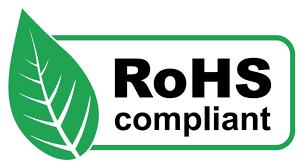


Another key strategy to attract and retain talent is modernising educational curricula. Academic programmes must be updated to reflect current industry practices and technological advancements. Incorporating topics such as automation, data analytics, sustainable mining and modern mineral processing practices can make these programmes more attractive and relevant.
Institutions should also revise their curricula regularly, for example every five years, to keep pace with industry changes and to ensure graduates are well-prepared for the job market. Collaboration between academic institutions and industry professionals can ensure that curricula are aligned with the latest industry standards, better preparing graduates for the job market. For example, offering practical experiences such as blasting camps and specialised courses can provide students with hands-on experience and skills that are highly valued in the industry. Organising events such as Minerals Camps where students gain practical, hands-on experience in geology, mining and processing, can further enhance their readiness for the modern mining industry. These initiatives demonstrate the commitment to equipping students with the necessary skills and the knowledge to succeed in their careers.

Another key strategy to attracting and retaining talent is to enhance awareness and outreach. Industry stakeholders, academia and the government should engage in programmes to educate students, parents and the public about the opportunities and advancements in the industry. Offering scholarships to students in relevant programmes will attract more students to this industry. Internships and industry-sponsored events will provide students with hands-on experience and exposure to modern mining and mineral processing technologies, sparking their interest in the field. Continuing education and professional development opportunities can also help current mining professionals stay updated with technological
advancements and industry trends, enhancing job satisfaction and career longevity. Flexible learning options, such as online courses and part-time programmes, can accommodate working professionals, ensuring they have access to ongoing education and skill development.
Other than that, promoting diversity and inclusion is also crucial to addressing the human capital crisis in the minerals and mining industry. This will help tap into a broader talent pool, bringing different perspectives and innovative solutions. This is particularly important in Malaysia, where women, minorities and other marginalised groups have traditionally been under-represented in the mining engineering field.
To foster diversity, initiatives such as mentorship programmes can provide guidance and role models for aspiring mining professionals from diverse backgrounds. Furthermore, creating inclusive work environments with policies that promote equity and belonging is essential for retaining a diverse workforce. By embracing diversity, the Malaysian minerals and mining industry can strengthen its resilience and drive progress in areas like sustainability and technological innovation, as seen in examples of success in other countries.
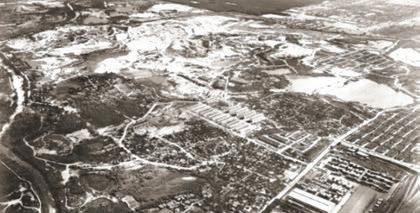
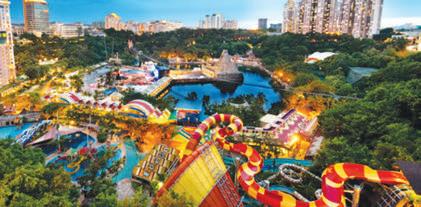
Global initiatives and programmes are making headways in addressing the mining industry’s human capital challenges. For example, Australia’s Mining Education Initiatives have boosted enrolment and graduation rates in mining-related disciplines through collaborations between universities and the minerals industry. The country has implemented several initiatives to strengthen mining education and workforce development. The Minerals Tertiary Education Council works with universities to enhance mining engineering programmes, offering scholarships and industry placements for students. These efforts have resulted in increased enrolment and graduation rates in mining-related fields.
Our products:




No. 45-3, Jalan PJU 5/20
The Strand, Kota Damansara 47810 Petaling Jaya Selangor Darul Ehsan
Tel : 603 6142 6638
Fax : 603 6142 6693
Email : jasonklc@nehemiah-grp.com
Email : julia@nehemiah-grp.com
Another example is Canada’s Mining Industry Human Resources Council (MiHR) which has launched programmes such as Mining Essentials and Gearing Up to increase the participation of under-represented groups such as indigenous communities, in the mining workforce. Mining Essentials provides training and employment opportunities for indigenous communities, while Gearing Up supports work-integrated learning for students. These programmes have successfully increased the number of under-represented groups in the mining workforce.
South Africa’s Skills Development Programmes offered by the Mining Qualifications Authority have helped build a more skilled and diverse mining talent pool. These initiatives address the shortage of mining professionals by supporting students pursuing mining-related degrees through bursaries, leadership and internships. The result is the development of a more skilled and diverse mining workforce.
Another example of promoting diversity and inclusion in the mining industry is Indian Zinc’s Female Mining Engineers Programme, which has launched several efforts to encourage and support women in mining engineering. This includes scholarships, mentoring programmes and recognition of female mining engineers on platforms such as the International Women in Mining Day. These initiatives have successfully increased the representation of women in the mining sector.
By learning from these global best practices and implementing similar targeted programmes, our mining industry can work to address its human capital challenges and build a more diverse, skilled and sustainable workforce for the future.
The future of mining education and workforce development lies in cultivating a dynamic and adaptable talent pipeline to meet the needs of the evolving industry. Key trends shaping this future include the growing emphasis on sustainability, the integration of digital technologies and the demand for cross-disciplinary skills.
Integrating technology and digital skills is crucial to staying competitive. As the industry increasingly adopts technologies like automation, artificial intelligence and data analytics, mining engineering programmes must incorporate these digital skills into the curricula. This will prepare students for the high-tech nature of modern mining operations. Collaborations with tech companies can provide students access to cutting-edge tools and platforms.
As the mining industry faces growing demands for sustainable practices, educational programmes must adapt the curricula to equip the next generation of mining professionals. With a focus on Sustainability & Environmental Stewardship, these programmes should incorporate topics such as environmental impact assessment, resource conservation and mine rehabilitation. This will ensure that future mining professionals are equipped to address critical environmental challenges. Case studies and field projects on sustainable mining can
further enhance student learning and understanding of these crucial issues.
Global collaboration and knowledge sharing is essential to address the mining industry's human capital challenges. This approach can help the industry leverage best practices and to address common mining education and workforce development challenges. Such collaborations include international research partnerships, student exchange programmes and global conferences. Platforms for virtual collaboration can further expand access to knowledge and resources. There is a growing recognition of the need for greater global engagement in the mining sector.
Industry groups and academic institutions should seek to forge more international partnerships to share expertise and insights. For example, establishing ties with different countries to facilitate knowledge exchange on effective workforce development initiatives can be beneficial. Additionally, exploring student exchange opportunities with leading global institutions will expose students to diverse mining practices and innovations, better preparing them for the evolving needs of the mining industry.
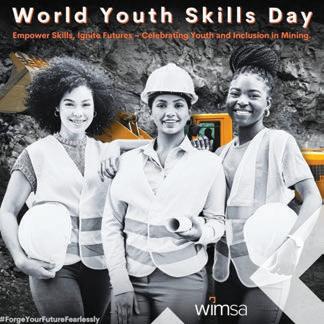
The mining industry is at the crossroads, facing a critical shortage of skilled professionals in mineral resources engineering. Addressing this human capital crisis requires a concerted effort from academia, industry and government to rebrand the industry, enhance awareness, modernise curricula, promote diversity and strengthen collaboration. By implementing these strategies, the industry can reverse the losses in human capital, secure a robust talent pipeline and continue to drive innovation and sustainability in the extraction and management of the Earth’s mineral resources. It is time to invest in human capital and ensure that the mining industry remains a vital and dynamic sector for generations to come.
“Tin is called the ‘spice element’ because a little of it is present everywhere in ways that are essential to our quality of life. Tin is currently used in a wide variety of products, including cars, houses and electronics.”
– The International Tin Association
The high demand for tin has caused the price of tin to soar to record highs, coming close to US$50,000 per ton in 2022, causing great excitement in the tin mining industry. The intention of this paper is to give a brief review of the industry from a former tin miner’s perspective. Is there tin at the end of the rainbow?
The age of artificial intelligence (AI) and the advancement of computer and communication technology have rapidly changed our world. Computers, electronic equipment, handphones, electric vehicles and batteries point to the need for one particular metal – tin! Yes, tin that comes from our mines which we all know about but yet, many may have forgotten!
Do you know that the main use of tin is for soldering in electrical components and circuit boards? Tin is commonly associated with the canning industry, so not many people realise that handphones have a bit of tin in them as the metal is used for soldering in the circuit boards of the handphones. The other main uses for tin are in the coatings of the casings of dry cell batteries and as an additive coating in the anode of batteries used in electric vehicles; demand for these will definitely increase as more countries switch from using petrol cars to electric vehicles.
The development of canning for the preservation of food in the mid-19th century saw the rapid growth of the tin industry in Malaya. With the discovery of large, rich tin

Prepared by: Ir. Yap Keam Min, FIEM, FICE, FIEAust, P.Eng, C.Eng, C.PEng NER Apec Engineer IntPE (Aust)
Civil and structural engineer, he is a fellow of IEM, a fellow of the Institution of Engineers UK and a fellow of the Institution of Engineers, Australia. He was the CEO/ technical director of a tin mine in Puchong (1980-1983) and managed a tin mine in Chenderiang, Perak (1983-1985).
fields in Perak and Selangor, Malaya became the world’s biggest producer of tin in the late 20th century and we produced as much as 50% of the world’s production. However, the country accounts for less than 1.5% of world production today. The main reason was the collapse of the world tin industry in October 1985 when the price of tin fell by 50%. The other factor was that no new tin fields were discovered.
Alluvial tin mining: The two most common methods of mining alluvial tin ore are gravel pump and dredging.
1.
Gravel pump is the most common method of tin mining. Tin-bearing earth is broken down by high pressure water jets known as monitors and the resultant slurry is washed to a sump in the pit floor. The ground is kept steep so that the slurry slides down to the sump by gravity. A gravel pump pumps all the material up to an elevated palong (a huge wooden sluice box to trap and save the tin ore).
A newer method is the dry method, where tin-bearing earth is carried by dump trucks to a collection pit in front of the palong. Here monitors are used to break, loosen and agitate the materials which then flow to the palong via gravity. This has proved to be highly effective as large volumes of tin-bearing earth can be treated. The modern method of recovering the ore is to use jigs, shaking tables and even spiral concentrators. However, palongs are still used as these can treat large volumes of tin-bearing earth, which is a main criteria in tin mining.

2. Dredging
Dredges are highly efficient mining machines which can operate practically nonstop for 24 hours, with labourers working on shifts. Earth with lower grade deposits can be profitable because of the high yardage of materials treated. The dredge is essentially a floating mine where mining and tin ore dressing are done on board. After the ore-bearing earth is dug up by chain buckets and broken down by monitors, jigs are used to wash the tin ore. Dredges are expensive and unless large pieces of land with rich deposits of tin are found, it is doubtful that dredges will be re-introduced.














Lode mining: Lode mining is carried out where the tin ore is found in lodes or veins in rock and boulders. Most of the tin ore mined in Malaysia were alluvial or placer ore which was relatively easier than lode mining.
Open cast primary tin: In areas where tin ore is found in rocks and boulders, the ore-bearing materials are dug by excavators and transported by dump trucks to a collection pit. The rocks are then crushed and go through a separation process. If the ore deposits are deeper, dynamite blasting is often used to extract the ore. At present there are a few such tin mines in operation at Pengalan Hulu in north Perak.
Underground mining: The other method of lode mining is underground mining. As its name implies, mining is carried out underground through tunnels and shafts. Underground mining requires high capital costs and higher technology. Even exploration works for primary tin are high capital investment and high risk. The most famous underground tin mine in Malaysia was in Pahang.
The industry has been in the doldrums for over 40 years and it will not be an easy task to revitalise this sleeping industry. Most of the tin miners (meaning the owners and investors, not the workers!) have moved on to other industries and some have even retired. Most large tin mining companies have changed their businesses and those listed on the KLSE were sold as shell companies.
Tin mining has always been a possible high return but high-risk venture. It has often been said that one needs capital and guts to venture into tin mining. To start a new tin mine today will require a huge capital and new technology.
The key skills people needed for hydraulic tin mining are as follow:
1. The mining engineer who is experienced in tin mining, including the preparation of mining schemes, the position of the palong and sizes of tailings ponds, the source of water, locating the tin ore bearing earths and control of tin mining operation according to governance.
2. The kepala (or headman) is the most important manager in a tin mine, especially in alluvial mining. He has the skills and knowledge of all the practical works in running a tin mine such as the design and construction of the palong, water and drainage control, safety of tin mines especially land subsidence, tin ore dressing and, of course, locating the ore.
3. The exploration team: Modern mining may require constant checking or searching for tin ore deposits.
4. Tin ore processor or dressers. The team that processes the raw tin orebearing material obtained from the palong or jigs into high concentration tin ore. The process may involve crushing and grinding, floatation method with jigs and shaking tables, magnetic separator and drying and packing. There is a premium for efficiency as the purer the ore, the higher the price.
Tin mining workers can still be sourced from Perak, previously the centre of tin mining activities in the world. Although activities have been slow over the decades, we are blessed with many sand mines. Sand mining operations are similar to that of tin mining except for the process to recover tin ore. Mining equipment such as pipes, gravel and water pumps can be sourced in Perak. The most important person is the kepala and it is very important to be able to get a good, experienced kepala who can assemble the required workforce.
New methods of tin mining have to be more efficient, sustainable and environmentally friendly; China, as the largest producer today, has many new and advanced mining equipment and techniques.




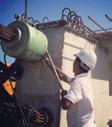
Nehemiah-OVM provides the following products and services:
- Post-tensioning solution provider
- Carpark Flat Slab
- Transfer Plate
- Beams, Box Girders
- Alternative design solutions
- Cable systems (stay cable, main cable, hanger)
- Bridge bearing and expansion joint
- Construction solutions (heavy lifting, ILM, etc)
- Monitoring repairing and strengthening for structures




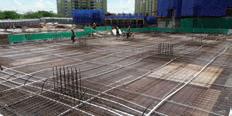
No. 45-3, Jalan PJU 5/20
The Strand, Kota Damansara 47810 Petaling Jaya
Selangor Darul Ehsan
Tel : 603 6142 6638
Fax : 603 6142 6693

Email : enquiry-pt@nehemiah-grp.com



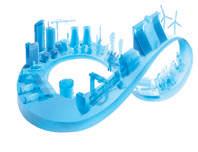
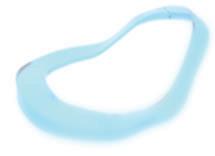

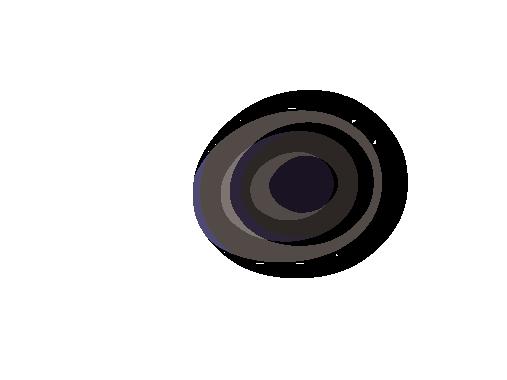

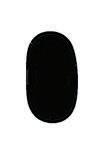



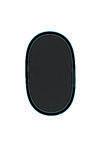
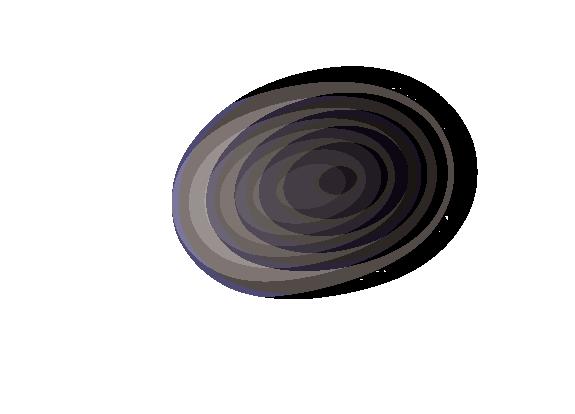
Traditionally, mining and the environment do not mix well! Environmental, social & governance (ESG) is a relatively new concept in Malaysia but unfortunately, many tin mining companies were not keen on ESG in the past. Mining activities often cause social problems for mines and the community. But the good news is that ESG is possible in tin mining and in many countries, this is a condition for the granting of a mining licence.
Sustainability is another new word for most tin miners. In the past, tin mining caused pollution and the silting of rivers. Ex-mining tailing ponds with slime or soft clay also made the land expensive to rehabilitate.
One new method that is good for the environment and has proved sustainable is backfilling mining where areas that are mined are continually backfilled. Also, with more ore exploration, only workable grades of tinbearing earth are mined which will reduce the cost and the volume of tailings waste.
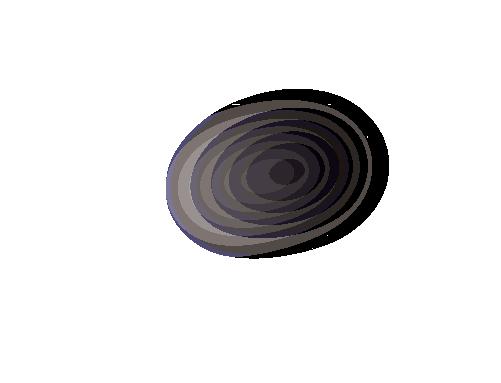






It had been proven that mining and conservation of the environment can co-exist as the rehabilitation of some mines has shown impressive results. For instance, oil palm has been successfully planted on ex-mining land. Construction on ex-mining land has also been carried out successfully and lots of ex-mining land have been turned into housing estates. Ex-mining pools are also being used for recreation purposes, such as golf courses and water sanctuaries.
For many years, tin mines provided sand for the construction industry. Malaysia is fortunate that some large mining pools have been turned into landfills. Ex-mining pools are also used for flood control (e.g. the SMART project).
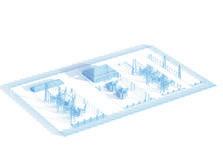
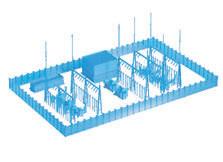
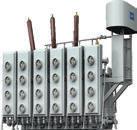




Much of our tin came from alluvial deposits and, for the last few decades, tin ore was mined from dredged out areas, old mines, the leftovers of the boundaries between two old mines and reworking of the tailings. Most of the known tin ore areas are of low grades.
There is a need to find new tin deposit land and the mother lode. Mining the mother lode will require a very large investment and the cost of production will be high.
Perhaps the government can play a role in facilitating the conversion of land, e.g. agricultural, etc., for mining, where land will be returned to the landowner to be used for other purposes after mining has ceased. The tin should be extracted before any development is carried out or the tin ore will be lost forever.
Some large alluvial reserves are located beneath developed towns and cities, making them obviously difficult to mine. For instance, the town of Gopeng in Perak is said to be sitting on very rich tin reserves. There was also an attempt to relocate the town for mining. Perhaps some day when the world tin reserves are very low, one can do underground mining in these towns.





High prices and the growing demand for tin is causing a huge interest in the industry. Tin is the metal of the future because of its high usage in the computer and electronic age, especially as world reserves of the metal are depleting and the demand will continue to increase. Traditionally, solders were made of a tin and lead alloy. But the new trend to use lead-free solders will increase the demand for tin. Hence there is a great future in tin mining.
The government may have to open up land for prospecting. The future of tin is probably in mining primary deposits but even exploration work for primary tin is a high capital investment with high risks.
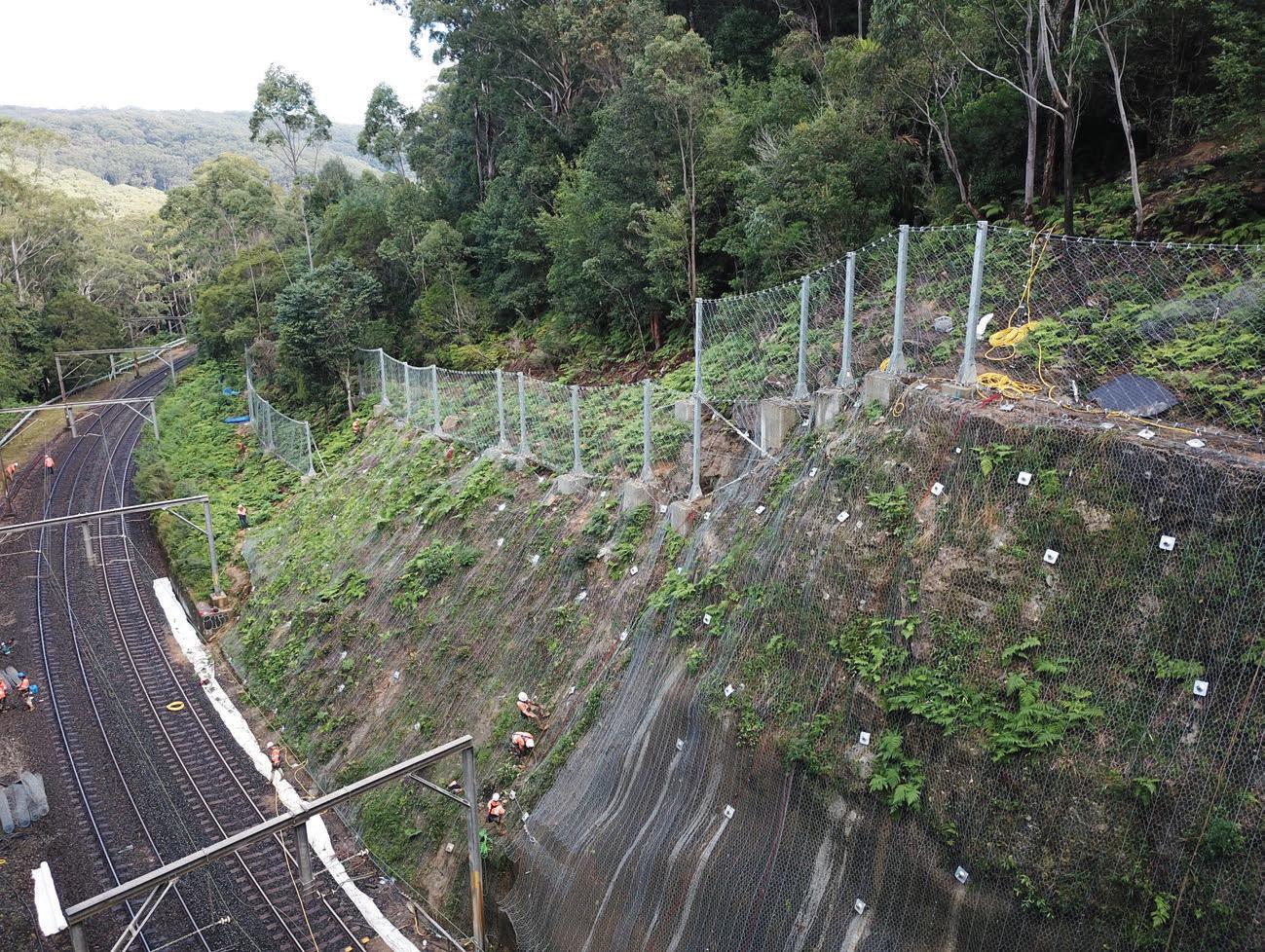

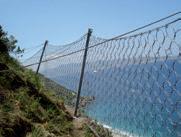
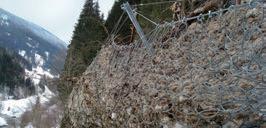
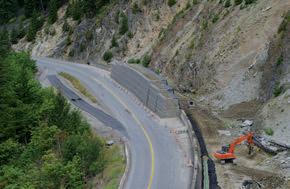

A piping system is widely used for the transfer of liquid or gas. Since all works of engineering constructions have a certain design life-cycle, piping systems also encounter wear and tear, eventually leading to pipe leaks. A worst scenario happens when offshore oil & gas (O&G) platforms experience a leak in the critical piping system, causing the loss of millions of ringgit in production as well as seriously affecting the facilities, safety, health and environment. O&G platforms are usually in isolated locations, so in view of the logistic constrains, proper responsive mitigation needs to be in place.
Any product utilised to mitigate leaking pipes needs to undergo proper evaluation in terms of safety, quality and technical aspects. An industrial recognised reference is the American Society of Mechanical Engineers, Repair of Pressure Equipment and Piping (ASME PCC-2), where

Since hot work is involved, any combustible residue inside the pipe should be removed prior to welding. Relatively longer work duration due to customised modifications. Quality is skill dependent (welder).
Remark:

Prepared by: Ir. Teo Eu Jin
A Corporate Member of IEM, registered Professional Engineer and ASEAN Chartered Professional Engineer with the Board of Engineers Malaysia, he works as an Integrity Engineer at a multinational O&G corporation.
pipe leak mitigation is categorised into Welded Repair, Mechanical Repair and Non-Metallic & Bonded Repair. The Composite Wrap is part of the Non-Metallic & Bonded Repair, whereby another standard BS EN ISO 24817, Petroleum, Petrochemical & Natural Gas Industries – Composite Repairs for Pipework – Qualification and Design, Installation, Testing and Inspection, can be used for cross comparison. This article will consolidate both ASME PCC-2 and BS EN ISO 24817 for discussion purposes.
Composite Wrap was actively explored in O&G offshore facilities in Malaysia around the beginning of the 21st century. In theory, a composite wrap can restore the integrity of pipe material that has undergone external corrosion, external damage, internal corrosion and erosion, crack-like defects as well as strengthen local areas. Nonetheless, internal corrosion and erosion will continue even after wrapping, while the others can

Fast and easy to install. Suitable for relatively high temperature service on straight pipe and not for complex configuration (e.g., elbow, tee), unless custom made. Fairly high inventory to cater to various pipe sizes.

Flexible to cater to complex configurations (e.g., elbow, tee). Needs specific control process such as material shelf-life and quality is skill dependent (wrappers) etc.
• For safety reasons, nearly all leaking pipes need to be properly isolated, drained and depressurised before any mitigation can be executed (except for mechanism designed for online leak repair).
• Per ASME PCC-2 clause 101-3.7, the standard does not classify repair method as permanent or temporary. In other word, it depends on the end user to decide the duration of the repair.
be mitigated without further deterioration, provided a good quality wrap is executed. To ensure the composite wrap is of acceptable quality, a few criteria need to be considered, such as repair system qualification, enquiry stage, design of repair, installer training, installation of repair and inspection and maintenance of repair.
In ISO 24817, not through-wall defect (e.g., wall lost below design criteria) and through-wall defect (e.g., leak) are termed Type A and Type B respectively. Also, the composite wrap design lifetime in calculation ranges from 2 years (min) to 20 years (max). Alternatively, a degradation factor may be used to substitute the design life in ISO. Some end users treat composite wraps as a temporary measure to buy time for a more permanent repair. Moreover, the repair class is segregated into Class 1, 2 and 3 (Table 2). Basically, the owner should confirm that the repair system proposed by the supplier had been tested as part of due diligence, meeting the standard with sufficient documentation and preferably with third-party verification.
Note: During the actual application, the owner needs to furnish the vendor with data for a proper wrap design. If there are changes in the piping system associate to the composite wrap in terms of pressure and/or temperature and injection of certain chemicals (acidic or alkaline), subsequent technical evaluation needs to be performed and when required, to take necessary action including decommissioning the composite repair.
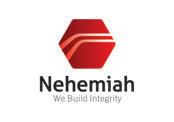
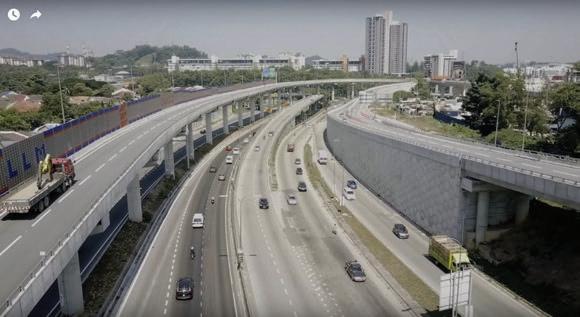
Class 1 Low specification duties, e.g. static head, drains, cooling medium and sea (service) water
Class 2 Fire water/deluge systems
Class 3
Produced water and hydrocarbons, flammable fluids, gas systems. Class 3 also covers operating conditions more onerous than those described above.
Limited to repairs designed in compliance with this document and of a thickness equivalent to <D/12
Defined in 7.5.3
(Clause in ISO 24817)
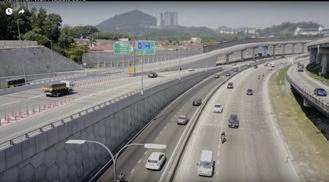

Remarks:
1. Class 3 repair is recommended to be more stringent at inspection and revalidation (refer Table 7).
2. Most owner will opt to prepare for Class 3 for worst case scenario.
Source: ISO 24817 (2017), Table 2, Repair Class
Composite Wrap Mock-Up Test: (Part of Design of Repair whereby Supplier shall demonstrate the repair system to be satisfactory)
Since ISO 24817 states that the supplier shall demonstrate the repair system to be satisfactory, some organisations may request proof testing (mock-up). There is a different strategy for approaching this mock-up test, where it is common to split the said test into phases.
enquiry@nehemiah-grp.com
The first phase comprises core testing on all relevant carbon steel piping components to verify the theoretical calculation (i.e., pipe, tee, etc.). Higher pipe geometrical changes may elevate the stress intensification which may need to be overcome by increasing the composite
wrap thickness. Subsequent mock-up test phases may be extended to other materials (e.g., stainless steel 316L, duplex stainless steel) where required, to ensure the established calculation principle is still valid. More importantly, the end user needs to be confident with the product.
Type A Defect: Minimum repair laminate thickness
For Hoop Stresses:

For Axial Stresses:

(Note: The greater thickness determined shall apply)
Type B Defect: Minimum repair laminate thickness (for a circular or near-circular defect)

Axial length of the repair
Length of the wrap should be: whereby,


A minimum taper of approximately 5:1 ratio (Example: 5x composite wrap thickness)
Alternative shorter repair length

This is permitted provided mock-up demonstrated is done.
Remarks:
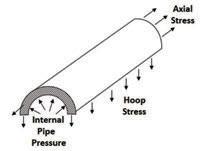
Legends (Refer to ASME PCC-2, Article 4.1 for more details)
D = component outside diameter, m (in.)
d = diameter of defect or leaking region, m (in.)
Ea = tensile modulus for the composite laminate in the axial direction, N/m2 (psi)
Eac = (Ea × Ec) 0.5, N/m2 (psi)
Ec = tensile modulus for the composite laminate in the circumferential direction, N/m2 (psi)
Es = tensile modulus for substrate material, N/m2 (psi)
F = sum axial tensile loads due to pressure, bending, and axial thrust, N (lbf).
f = service factor for Type B repairs
f T = temperature derating factor
G31 = composite laminate shear modulus, N/m2 (psi)
P = internal design pressure, N/m2 (psi)
Ps = Maximum Operating Pressure, N/m2 (psi)
s = Specified Minimum Yield Strength, N/m2 (psi)
t = nominal wall thickness, mm (in.)
t min = minimum repair thickness, mm (in.)
t repair = design repair thickness, mm (in.)
ƳLCL = toughness parameter lower confidence limit
ϵ
a = allowable axial strain
τ = lap shear strength, N/m2 (psi)
ν = Poisson’s ratio for the composite laminate in the circumferential direction
Note:
ISO 24817, Clause 7.5.8 states that the minimum L over of 50mm may be taken into consideration.
a. The above reference formulae are from ASME PCC-2 Part 6 meant for consideration only.
b. Moreover, the formulae in ASME PCC-2 may be slightly different with ISO 24817.
c. The value of the variables is obtained during composite wrap system qualification test.
Basic Steps Application of Composite Wrap on Through-Wall Defect (Type B)
Check Steel Pipe Surface Preparation
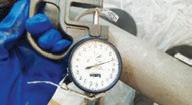
Temporary Compress the In-fill Compound
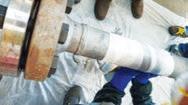
Apply the Saturated Wrap on the Pipe

Perforate the Plastic

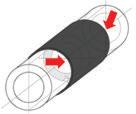
Prepare the In-fill Compound
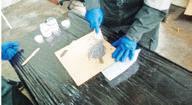
Saturant to the Fibre Wrap
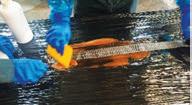
Massage the Composite Wrap
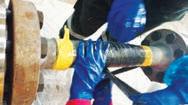
Wait till fully cured and then verify the hardness

Seal the Hole with In-fill
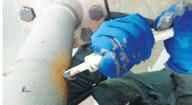
Apply the Primer (Interphase) on the Pipe
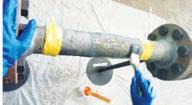
Compress the Composite Wrap with Plastic
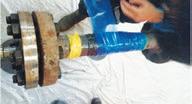
Remarks:
Pressure test the sample coupon according to the desired pressure rating.
Remarks:
Red arrows on the left indicate common corrosion areas of a carbon steel pipe after a composite wrap application. Damage on the edges create an opening for water ingress and the trapped water causes accelerated corrosion underneath the wrap. Refer to ISO 24817 Table 16, 17 and 18 for more information on visual inspection.
Safety, Health & Environmental (SHE) Tips:
In the case of chemical substances (including composite substances) sent to O&G offshore facilities, the latest Material Safety Data Sheet (MSDS) must be reviewed upfront as part of safety precautions. Moreover, the MDSD will also contain other useful information such as storage condition, First Aid treatment, etc.
Flow Chart

Remark:
Supplier or Vendor Supplier needs to do the necessary pre-requisites to ensure the product complies to the industrial standard (e.g., testing and calculation). The end user should verify this information during upfront discussion.
Supplier and End User
End User
Information stated in supplier document may not be the actual case at site. Therefore, end user is advised to perform due diligence by conducting mock-up test to ensure the product is fit-for-use.
Refer to Table 7, the composite wrap will be applied at operating facilities which falls under end user custodian. Hence, end user has the responsibility to track and record the composite wrap from cradle to grave.
If “R”, either supplier must improve or end user must reject/look for an alternative.

• Leak or defect detected on the pipe spool in the facilities.
• Evaluate the defect and determine whether composite wrap repair is the best way forward with alignment from stakeholders.
• Conduct engineering calculation to determine the wrap length and thickness required to mitigate the finding, including necessary information and instruction (e.g., repair steps) for reference.
• Apply composite wrap by competent person (trained); crew to refer to the established procedure to ensure quality of the work is achieved.
• Ensure necessary surface preparation and hardness test verified prior to system back online. This stage is best done with sufficient site supervision.
• If leak is not observed after system is back online, then this composite wrap can be considered acceptable for the time being. Make proper tracking and record for traceability purpose.
• Depending on the company strategy, some organisations allow composite wraps to be used long-term while other will not. However, it is wise to take precautions on composite material degradation.
• Composite wraps ought to be inspected at reasonable intervals to ensure their integrity is maintained via visual inspection. However, for Class 3 repairs, ISO 24817 mentions inspection considerations to check the condition of pipe beneath the repair via RT and eddy current to ensure no defect growth and no delamination (Type A > 2 years and Type B per risk assessment).
• Re-validation or extend the lifetime by redesigning the repair with the latest data (e.g., defect size, pressure, temperature, etc.) which may lead to thicker new composite repair. Moderate lifetime extension is recommended for composite wrap lifetime > 20 years with increment ≤ 5 years.
Site Application, Inspection and Monitoring Programme: (Installer Training, Installation of Repair, and Inspection and Maintenance of Repair)
Generally, correct installation will determine the success of composite wrap repairs. So it is crucial that the repair installer/wrapper is well trained. Some offshore O&G owners will directly engage repair installer personnel on an ad-hoc basis, while others may train their regular offshore crew members.
ISO 24817 recommends 10 wraps per year for the qualification to be valid or else undergoing requalification annually is required. Since composite wraps are not impervious to defect, it is wise to have an inspection plan (with photo) in place based on risk level and timeline. In fact, there are cases of composite wrap failures, such as interfacial delamination, external physical damage and bulges.
Some may argue that welding and clamping are better than composite wrap. That may be true in some sense. But though a composite wrap may fail, the associated risk is reduced as the consequence typically changes from uncontrolled rupture failure of substrates (without wrap) to controlled leak or dripping (with wrap). For now, the inspection of composite wraps is limited to visual, radiographic testing (RT), eddy current and other relevant techniques (e.g., tapping to determine delamination). Basically, RT is a feasible way to assess the pipe beneath the composite wrap (especially after visual finding) but the execution window for RT is limited on offshore O&G platforms. Too many composite wraps may lead to an inspection backlog. Therefore, end-users ought to establish pipe repair strategy to optimise the advantages of a composite wrap.
[1] The American Society of Mechanical Engineers, ASME PCC-2 (2015) “Repair of Pressure Equipment and Piping”.
[2] BSI Standard Publication, BS EN ISO 24817 (2017), “Petroleum, petrochemical and natural gas industries – Composite repairs for pipework – Qualification and design, installation, testing and inspection”.
[3] External Surface Cracked Offshore Pipes Reinforced with Composite Repair System: A Numerical Analysis, Theoretical and Applied Fracture Mechanics, Elsevier, Vol 117, Feb 2022, by Zongchen Li, Xiaoli Jiang, Hans Hopman.


A notice inviting nominations for the Election of Council Members for Session 2025/2026 will be posted on the IEM Notice Board and IEM website by 1 November 2024 for the information of all Corporate Members of IEM. Following the close of nominations on 7 December 2024, the election exercise will proceed. All Corporate Members residing overseas are requested to take note of the requirements of the Bylaw, Section 5.17, as shown below.
The voting paper (in hardcopy or electronic form) shall, not less than twenty-eight (28) clear days before the date of the Annual General Meeting, be sent by post or in electronic mail or message to all Corporate Members. The voting paper (in hardcopy or electronic form) shall be returned or submitted online and in turn notified to the Honorary Secretary in a sealed envelope or electronically encrypted format so as to reach him by a specified date not less than seven (7) days before the Annual General Meeting.
Electronic Ballot Papers will be sent to all Corporate Members by 3 March 2025
Thank you. Election Officer, IEM












Encouraged by the hospitality of the Selinsing Gold Mine team during technical visits in the years prior to the COVID-19 pandemic lockdown, the Oil, Gas & Mining Technical Division (OGMTD) once again organised another technical visit to the mine in Kuala Lipis, Pahang, on 23 June 2024.
The mine had always been a key visit location on OGMTD’s list of activities due to requests by its members and public interest in the commodity in recent years.
The Selinsing Gold Mine, operated by Selinsing Gold Mine Manager Sdn. Bhd. (SGMMSB), is located in Bukit Selinsing near Sungai Koyan, approximately 65km north of Raub and 30km west of Kuala Lipis. The 26 participants comprising OGMTD members and non-members, left in a chartered bus from Wisma IEM at 7.45 a.m. and we reached our destination after a 2.5-hour journey.

Prepared by: Ir. Ahmad Rafidi Mohayiddin
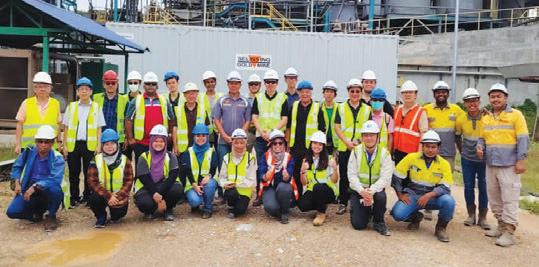
We were received by Encik Zaidi Haron, Senior Vice President of SGMMSB, and his team. The visit started with a warm welcome by Encik Zaidi Haron who also gave us a short history of the site. Then there was a safety briefing for the participants before we went to the mine. Most participants had brought along their own personal protective equipment (PPE) but SGMSSB had also prepared extra equipment such as safety vests.

We learnt that the Selinsing deposit occurs along the north striking Raub, Bentong Suture and a major tectonic feature that runs through Peninsular Malaysia. The deposit is hosted by a series of auriferous quartz veins and stockworks of quartz veinlets in a package of sheared calcareous epiclastic sediments. Gold mineralisation at Selinsing is associated with high grade quartz veining and associated sericitisation and silification within a major shear zone. Encik Zaidi Haron then talked about the process of extracting gold deposits and the ongoing activities. The participants went to the mine in a few pick-up vehicles. The first stop was the open mine blasting and drilling area. There, they had the opportunity to view one of three new pits where blasting and drilling were being carried out. There were heavy machineries and we saw trucks carrying loads of crushed rocks and trucks carrying waste to collection areas. Selinsing Mine also has its own laboratory for analysing the quality of deposits in the rock samples.

The next stop was the area where crushed rocks were collected. Participants disembarked from the pickup vehicles for a closer look at the crushed rocks and to listen to further briefings on visual assessment of various features seen on the rock surface.
On the ride to the next collection area, participants passed by tailing dams where the waste was stored and treated. At the next stop, the collected rocks were further crushed before being loaded into the crusher and refined further prior to being fed into the new Sulphide Floatation Plant.
We were informed that SGMMSB no longer produced raw gold bars but relied on this plant to treat sulphide ore in three stages of a cleaner flotation process which eventually resulted in a thickened slurry of a gold concentrate cake. This cake was shipped to overseas buyers for the gold to be extracted.
The participants had a group photograph taken in front of the plant before they returned to the canteen for a sumptuous lunch. After bidding adieu, the bus left the mine at 2.30 p.m. with participants having gained valuable insights and new knowledge in gold extraction from the team at SGMMSB.
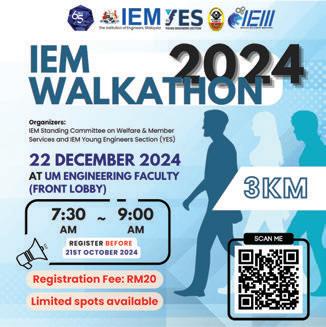
NOMINATIONS FOR ELECTION TO FILL VACANCIES FOR THE COUNCIL
The IEM Council at its 442nd meeting on 15 July 2024 had decided to fill Council vacancies for the Session 2025/2026 in accordance with Article 5.2 of the Constitution. An election programme had also been approved by the Council for implementation.
The following Council vacancies will arise for Session 2025/2026 as a result of Council members retiring at the end of Session 2024/2025.
Office
Vice President
No of Vacancies
Term of Office
Four (4) 2 sessions (2025/2026 and 2026/2027)
Honorary Secretary One (1) 1 session (2025/2026)
Honorary Treasurer One (1) 1 session (2025/2026)
Council Member
– Other Discipline
Council Membe
– Ordinary Representative
One (1) 3 sessions (2025/2026, 2026/2027 and 2027/2028)
Ten (10) 3 sessions (2025/2026, 2026/2027 and 2027/2028)
Notice inviting nominations for the Election of Council Member for Session 2025/2026 will be posted on the IEM Notice Board and on the website on 1 November 2024 for the information of all Corporate Members.
Nomination Forms may be obtained at the IEM Secretariat or downloaded from the IEM website www.myiem.org.my on and after 1 November 2024
All Nomination forms, duly completed, shall be sent in a sealed envelope marked “Confidential: Nomination Paper for Session 2025/2026” to: -
The Honorary Secretary
The Institution of Engineers, Malaysia BangunanIngenieur, Lots 60/62, Jalan 52/4 P.O. Box 223 (Jalan Sultan) 46720 Petaling Jaya, Selangor DarulEhsan Tel: 03-79684001/2
and to reach her not later than 12.00 noon on Saturday, 7 December 2024
Dato’ Paduka Ir. Hj. Keizrul bin Abdullah Election Officer 2024/2025


Annual Reports • Booklets • Brochures • Buntings • Business Cards
CD / DVD Replications • Calendars • Cards & Invitations • Certificates
Custom Printings • Envelopes • Folders • NCR Bill Books • Notepads Leaflets • Letterheads • Paper Bags • Posters • Stickers • Others




The 2nd annual WE IEM Conference 2024 was held at the Kuala Lumpur Convention Centre on 21 September 2024. Organised by the Women Engineers Section in conjunction with ENGINEER 2024, it focused on the integration of Environmental, Social & Governance (ESG) principles with global talent and diversity to drive sustainable development.
The event brought together 100 participants from various sectors, including engineering, business and academia. The theme for this year, ESG: Leveraging Global Talents & Diversity, was built on the success of last year’s conference, which focused on women empowerment and leadership.
The event began with welcoming remarks by Ir. Prof. Dr Zuhaina Zakaria, the Organising Chair of the conference. She said diversity and global talents are key drivers in developing innovative and equitable solutions to the challenges of today’s world. This was followed by a speech from IEM President Ir. Prof. Dr Jeffrey Chiang Choong Luin who expressed gratitude for the continued support of the Women Engineers Section. He then reinforced the importance of integrating ESG into the engineering profession.
Prepared by:

The keynote address was delivered by YB. Dr Zaliha Mustafa, Minister in the Prime Minister’s Department (Federal Territories). She talked about the importance of leading Malaysia towards a more inclusive and sustainable future, touching on several key areas such as:
• Global Talents & Diversity: Dr Zaliha underscored the importance of leveraging global talents and diversity to address the complex challenges of ESG, stating that diversity drove innovation and opened pathways to more inclusive solutions.
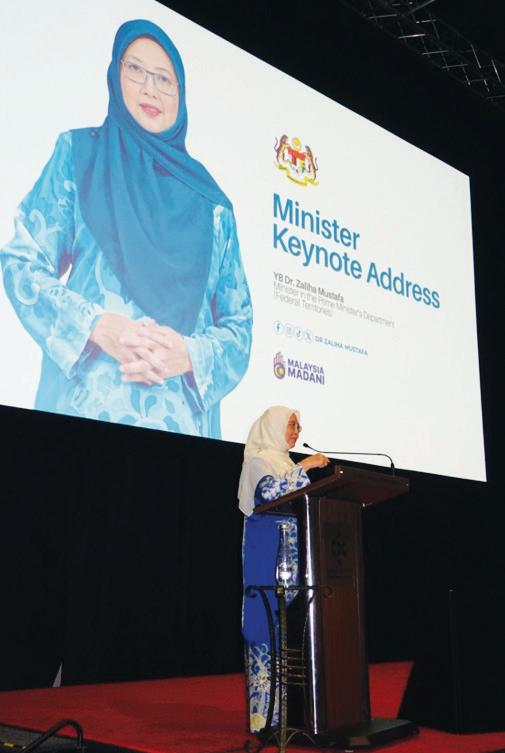
• Inclusive Engineering: She introduced the concept of inclusive engineering, encouraging practices that considered not just technical aspects but also social impact, equity and environmental sustainability. She urged IEM to lead the charge in promoting this approach.
• Malaysia’s Role in ESG: She affirmed that Malaysia was well-positioned to become a leader in integrating ESG principles into national development, citing the country’s diverse talent pool and commitment to sustainability as our key strengths.
Dr Zaliha concluded her speech by calling for greater collaboration between government, industry and academia to set new standards in promoting inclusivity and innovation.
• Forum 2. Addressing ESG Targets in STEM through Diversity
The second session focused on how diversity in STEM fields could accelerate progress toward ESG targets, particularly through innovation and collaboration.
The panellists were Ir. Ts. Dr Khor Jeen Ghee, Dr Eu Poh Leng, Ms. Ong Jee Lian and Ms. Hooi E-Wen. The moderator was Ir. Assoc. Prof. Dr Syuhaida Ismail.
The conference concluded with a speech from Ir. Assoc. Prof. Dr Syuhaida Ismail, Chair of the IEM Women Engineers Section. She thanked all the participants, speakers and sponsors for their contributions and encouraged everyone to carry forward the insights gained from the conference into their respective fields.
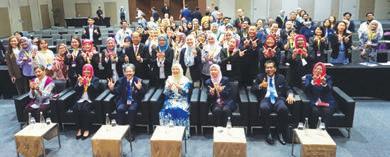
The conference featured three distinguished keynote speakers who shared their expertise on ESG and diversity:
1. Datuk Ir. Rosaline Ganendra: The founder of Ganendra Ahmad & Associates Sdn. Bhd. Talked about how integrating ESG principles into engineering practices could foster accountability, transparency and innovation.
2. Dato' Ir. Nor Hisham Mohd Ghazali: The Director of SK Water Consult Sdn. Bhd. discussed water management within the context of ESG, highlighting the critical role that sustainable water resource strategies play in environmental stewardship.
3. Dato' Prof. Dr Noraini Idris: The President of the National STEM Association focused on the role of STEM education in achieving ESG goals, stressing the need to cultivate future leaders who could address sustainability challenges through innovation.
The two forum sessions at the conference centred on leadership, diversity and ESG:
• Forum 1. Diverse Leadership in ESG: Shaping the Future Together
This session explored the importance of diverse leadership in driving ESG initiatives. The panellists shared practical insights and real-world examples of how inclusive leadership models could enhance decision-making and innovation.
The panellists were Ir. Sharifah Azlina Raja Kamal Pasmah, Encik Shahrul Nizam Md. Nur and Ir. Augusta Lee, with Ir. Rusnida Talib as moderator.
The WE IEM Conference 2024 successfully highlighted the importance of integrating ESG principles with diverse talents to create a more sustainable and equitable future. The event provided a platform for exchanging ideas, fostering collaboration and exploring innovative solutions to today’s challenges. The insights shared during the conference will continue to inspire and drive progress in promoting diversity and sustainability within the engineering sector.
The organising committee would like to extend its heartfelt gratitude to all the keynote speakers, panellists, attendees and sponsors for their support and participation. Special thanks are extended to YB. Dr Zaliha Mustafa for her inspiring keynote address and support for the event.
IEM Council and Management would like to extend our heartiest congratulations to
Datuk Ir. Willy Chin Tet Fu for being conferred the Panglima Gemilang Darjah Kinabalu (P.G.D.K.) which carries the title “Datuk”.
Dato' Indera Ir. Prof. Dr Lee Sze Wei for being conferred the Darjah Kebesaran Mahkota Pahang Yang Amat Mulia- Peringkat Pertama Sri Indera Mahkota Pahang (S.I.M.P.) which carries the title “Dato’ Indera”.
Dato’ Paduka Ir. Hj. Prof. (Dr) Keizrul Abdullah for being conferred the Anugerah Tokoh Kejuruteraan Negara 2024 by Board of Engineers Malaysia on 3rd October 2024.
Ir. Assoc. Prof. Dr Hassimi Abu Hasan for being conferred the Tokoh Muda Kejuruteraan Negara by Board of Engineers Malaysia on 3rd October 2024.


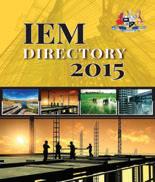
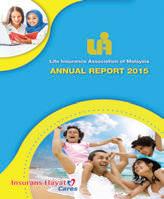







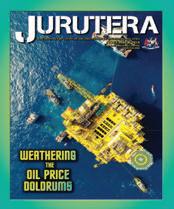

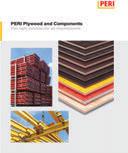








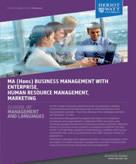

















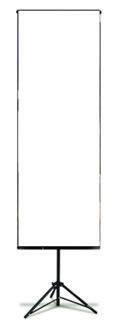
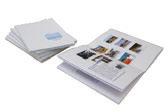



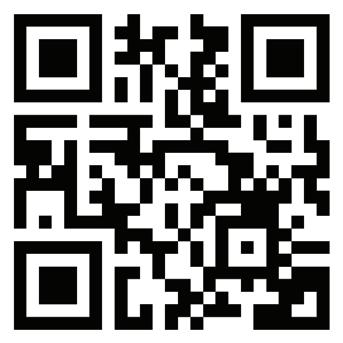


While attending CAFEO 24 in Kota Kinabalu, Sabah, from 22-24 October 2024, several IEM members took the opportunity to visit Semporna for a brief dive session. The dive base was Selakan Island, a location recognised for its vibrant underwater ecosystem. The group enjoyed a unique communal experience which reflected the close-knit island lifestyle and had meals prepared by local residents.
During the dive, they were thrilled to document a juvenile cryptic frogfish; this marked only the second sighting of this species in Semporna and the first around Selakan Island. The discovery was made with the help of the dive guide, Nathan, whose expertise in spotting rare marine life added a special highlight to the experience.


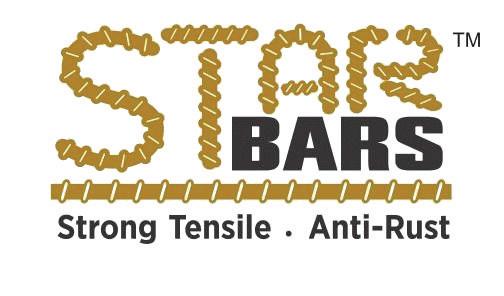


STARBARS ARE:
1. GLASS FIBRE REINFORCED POLYMER (GFRP) BARS
2. CHEAPER BY 15% COMPARED TO STEEL
3. CORROSION RESISTANCE
4. 2X HIGHER TENSILE STRENGTH
5. 4X LIGHTER THAN STEEL
6. NON-CONDUCTIVE TO THERMAL AND ELECTRICAL
7. 70% CARBON EMISSION REDUCTION
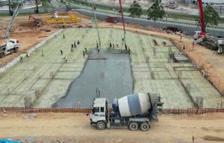
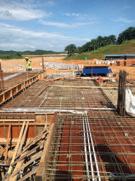
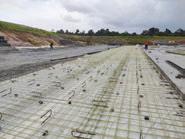





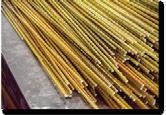
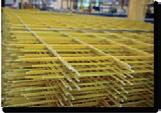
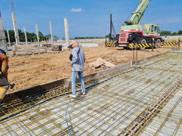
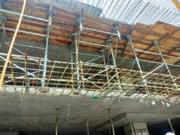
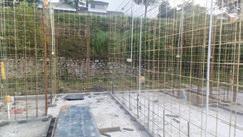







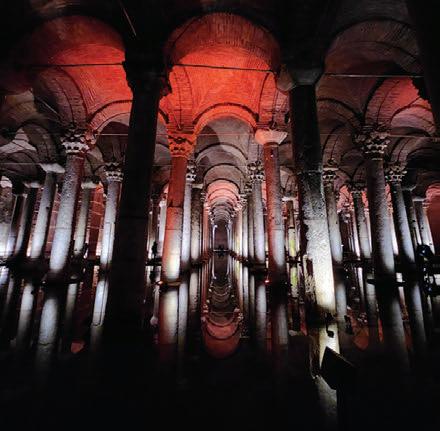
Are you familiar with rainwater harvesting tanks or storage used for landscaping, flushing and other non-potable purposes? Let’s take a look at an ancient engineering marvel, a cistern. This was a storage system buried underneath a city for holding water and as part of stormwater management for the Great Palace, nearby bathhouses and the surrounding community.
The Basilica Cistern, one of the largest ancient cisterns built in the 6th century AD during the Byzantine Empire, is still standing today as a historical and engineering wonder of Istanbul, Turkiye. Located in the district of Balat, this famous landmark has been open to tourists since 1987. Forget the typical smallscale rainwater harvesting tanks or storage tanks made from concrete, plastic, fibreglass or metal; visiting the Basilica Cistern is an eye-opening journey.
Able to store 80,000 cubic metres of water, the Basilica Cistern measures 138m by 65m and stands at 9m in height (about that of a 3-storey building). This underground reservoir is supported by 336 marble and granite columns rising majestically from the floor to the ceiling. They are arranged in 12 rows of 28 columns spaced 5m apart to evenly support the weight of the structure. These architectural elements ensure structural stability even during earthquakes. Many of the columns are said to have been reused or repurposed from older ancient structures or ruins. The most famous column, which is supported by a Medusa head at the base, is believed to have originated from Roman structures.
The uniqueness of ancient engineering lies in reliable and functional structures with aesthetic features. One of main elements of water or material engineering is the lining or waterproofing used to preserve the integrity of the structure and to maintain water storage quality. Sufficient water is still being kept
Prepared
by:

Ir. Ts. Nur Azhani Mohamad Rosli
Graduated from Universiti Teknologi PETRONAS with a Bachelor’s dregree in Electrical & Electronic (Instrument & Control) Engineering and a Master’s degree in Asset Maintenance & Management Engineering.
in the cistern to protect the structure and to provide moisture for its walls. Water scarcity and quality had been an issue since ancient times and such an engineering solution provided the water storage solution.
The Basilica Cistern is strategically placed in the centre of communities, designed to catch rainwater as well as freshwater flowing from the distant hills in Istanbul to the Black Sea. Furthermore, the cistern also provides a natural water filtration and purification system to ensure a reliable clean water supply even during the drought seasons. We can learn from such ancient engineering innovations which remain a mystery today. The Basilica Cistern is more than just a reservoir; it is an adventure into the impressive ancient engineering of the Byzantine Empire’s water system and its legacy continues to inspire wonder today.
Note: What’s the difference between a well and a cistern? A well collects groundwater, while a cistern collects rainwater. Both are important for a water management system.
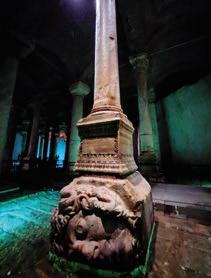
To all Members,
Date: 22 October 2024
LIST OF CANDIDATES ELIGIBLE TO SIT FOR THE PROFESSIONAL INTERVIEW FOR THE YEAR 2024
The following is a list of candidates who are eligible to sit for the Professional Interview for the year 2024.
According to the IEM Bylaws, Section 3.8, the names listed below are published as eligible candidates to become Insitution Members, provided that they pass the Professional Interview in 2024.
If there are any Corporate Members who have objections against any candidate deemed unsuitable to sit for the Professional Interview, a letter of objection can be submitted to the Honorary Secretary, IEM. A letter of objection must be submitted within one month from the date of publication.
Ir. Prof. Dr Tan Chee Fai IEM Honorary Secretary
NAME
ELECTRICAL ENGINEERING
SYAHNUR FITRI BIN MOHD HILMI RAJA
MECHANICAL ENGINEERING
ABDUL HAADI BIN ABDUL MANAP
MEMBERS
ENGINEERING 127540
Pengumuman yang ke-192
SENARAI PENDERMA KEPADA WISMA DANA BANGUNAN IEM
Institusi mengucapkan terima kasih kepada semua yang telah memberikan sumbangan kepada tabung Bangunan Wisma IEM. Ahli-ahli IEM dan pembaca yang ingin memberikan sumbangan boleh berbuat demikian dengan memuat turun borang di laman web IEM http://myiem.org.my atau menghubungi secretariat di +603-7890 0130 / 136 untuk maklumat lanjut. Senarai penyumbang untuk bulan September 2024 adalah seperti jadual di bawah:
No. No. Ahli Nama
1 104257
Mr. Ahmad Nassaruddin bin Kamaruzaman
2 30536 Mr. Mohd Dalias bin Awi
3 36347 Mr. Hiew Fong Poh
4 20719 Mr. Su Lay Chiew
5 43805 Mr. Shiridharan A/L Ganesan Muthi
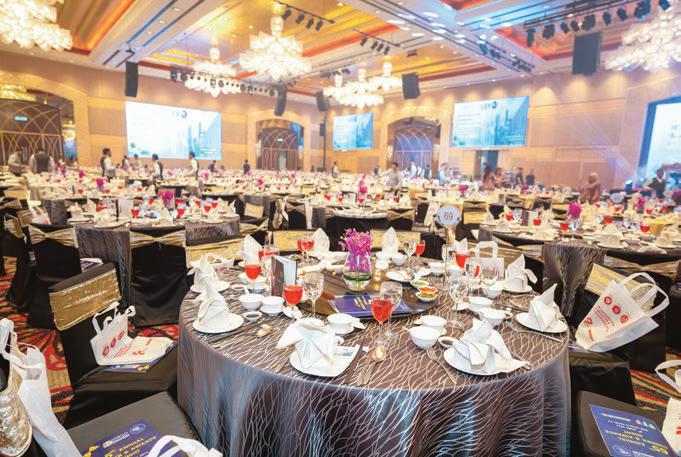
MECHANICAL ENGINEERING 127189 MOHD HISHAMUDDIN BIN MAT YASHIM BE HONS (UKM) (MECHANICAL & MATERIAL, 2005)
MARINE ENGINEERING 116222 SARAVANAN VENKADASALAM DIP (POLITEKNIK UNGKU OMAR) (MARINE, 2001)
TRANSFER TO CORPORATE MEMBER MEMBERS NO. NAME QUALIFICATION
CIVIL ENGINEERING
62165 MICHELLE CHUA YEE WEN BE HONS (TASMANIA) (CIVIL 2010)
MECHANICAL ENGINEERING
81424 TENG WENG SERN BE HONS (UTAR) (MECHANICAL, 2011)
90110 MOHD RAZALI BIN PAIMIN BSc HONS (COLORADO) (MECHANICAL, 1998)
31324 HAFIZ BIN MOHD YUSOF BE HONS (UITM) (MECHANICAL, 2010)
MECHATRONICS ENGINEERING
116616 AHMAD JAZLAN BIN HAJA MOHIDEEN BE HONS (UIAM) (MECHATRONICS, 2009) MSc HONS (UIAM) (MECHATRONICS, 2012) PhD (WESTERN AUSTRALIA) (2016)

6 6 t h A n n u a l D i n n e r
6 6 t h A n n u a l D i n n e r 66th Annual Dinner & & & A w a r d s N i g h t A w a r d s N i g h t Awards Night ESG: Engineering for a Greener Tomorrow
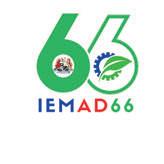





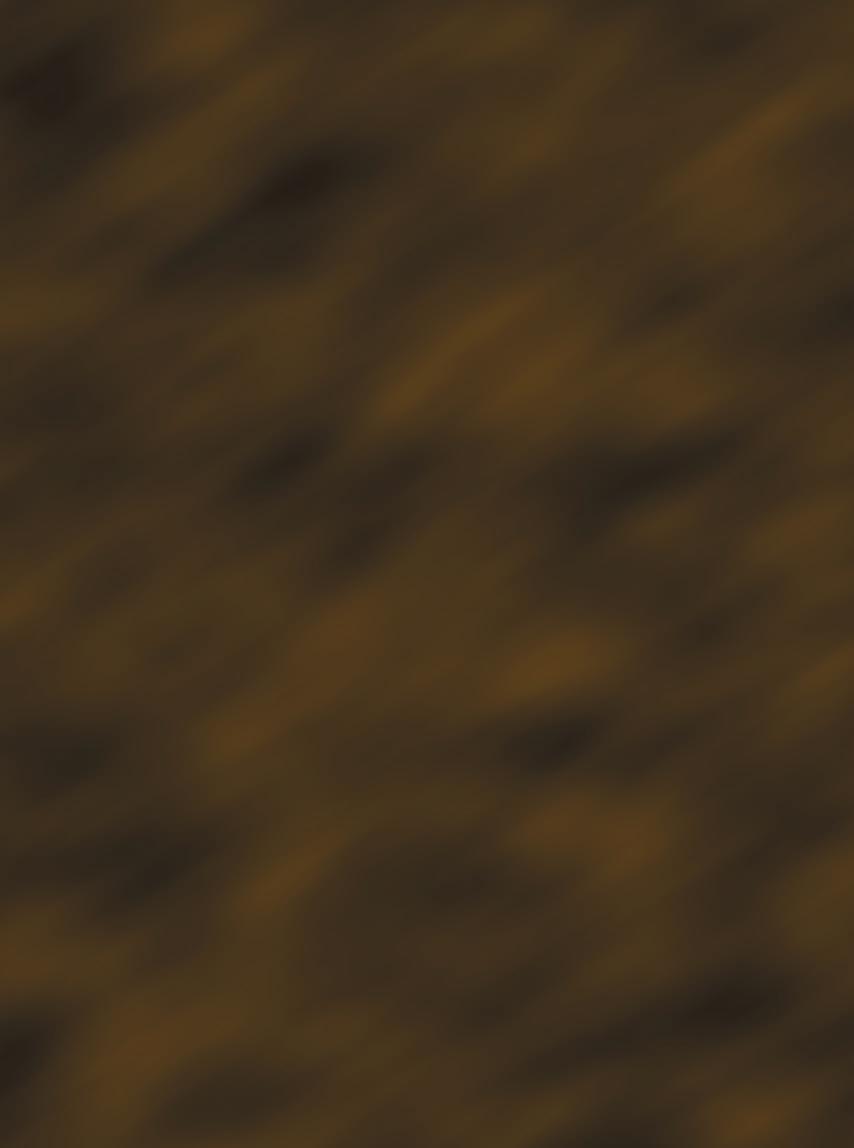
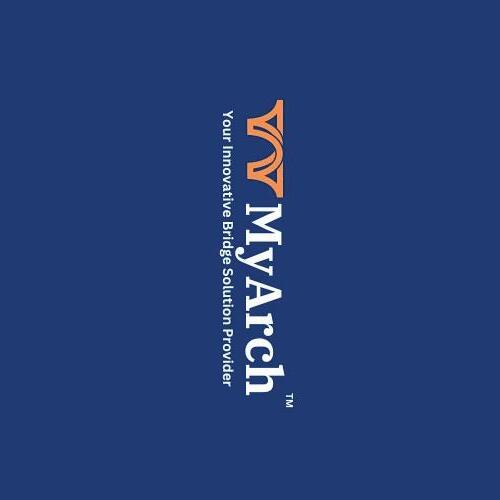
We are excited to announce that, effective
Bebo Arch International AG , the world leader in segmental arch solutions, has appointed MyArch Sdn Bhd as their official Bebo System Licensee for Malaysia (except Sabah).
As Malaysia's premier segmental bridge solution provider, this partnership allows MyArch to combine its expertise with Bebo Arch’s advanced technology , delivering even better infrastructure solutions across the country. We look forward to the opportunities this collaboration will bring.


MyArch Managment

CONTINUATION FROM OCTOBER 2024 ISSUE
PERMINDAHAN KEPADA AHLI SISWAZAH No. Ahli Nama Kelayakan
KEJURUTERAAN AWAM
52107 JOYNER ANAK MANGGANG BE HONS (UNIMAS) (CIVIL, 2016) ME (UNIMAS) (CIVIL, 2017)
87733 KHO JIA YANG BE HONS (UNITEN) (CIVIL, 2019)
105880 LAI LIK SHENG BE HONS (UTAR) (CIVIL, 2020)
116083 LAU YUNG CHIN BE TECH HONS (UTHM) (CIVIL, 2020) ME (UKM) (CIVIL, 2022)
74827 LIM PEI SHIH, FELICIA BE HONS (UTM) (CIVIL, 2018) ME (UTM) (STRUCTURE, 2019)
87742 MOHAMAD ASYRAF
BIN FADZIAL BE HONS (UNITEN) (CIVIL, 2019)
65770 MOHAMAD RADZI
BIN ZAIDI BE HONS (UiTM) (CIVIL, 2014)
94209 MOHAMAD YUSREE
BIN MOHD YUSOF BE HONS (UTHM) (CIVIL, 2020)
83265 MOHD HELMI CHUA
BIN MAHADY BE HONS (UTHM) (CIVIL, 2018)
33080 MOHD SAIFUL BAHRI
BIN MOHD ARIFFIN BE HONS (UiTM) (CIVIL, 2008)
71168 MUHAMAD AKRAM
BIN ABD KADIR BE HONS (UTM) (CIVIL, 2019) ME (UPM) (HIGHWAY AND TRANSPORTATION, 2022)
52126 MUHAMMAD FARABI
BIN ABDUL ROPA BE HONS (UNIMAS) (CIVIL, 2016)
95655 MUHAMMAD HASIF
BIN CHE AWANG BE HONS (UNITEN) (CIVIL, 2022)
79504 MUHAMMAD MUSTAZA
BIN ABD KADIR BE HONS (UTM) (CIVIL, 2017)
92088 MUHAMMAD RAHIMI
BIN AYOB BE HONS (UTHM) (CIVIL, 2020)
91298 MUHAMMAD RYDHWAN BIN ABDUL RAHIM BE HONS (UTHM) (CIVIL, 2020)
109073 NG WEI HAN BE HONS (SEGI) (CIVIL, 2023)
43225 NOORAFIQAH BINTI NGAINI BE HONS (UMS) (CIVIL, 2012)
88457 NUR ATIQAH BINTI HALIM BE HONS (UiTM) (CIVILINFRASTRUCTURE, 2018) ME (UPM) (HIGHWAY & TRANSPORTATION, 2020)
33430 NUR SYAZLINA BINTI MOH SAMSUDIN BE HONS (UiTM) (CIVIL, 2010)
47280 NURSYUHADA BINTI MAHAMOOD BE HONS (UTP) (CIVIL, 2015) MSc (UTP) (CIVIL, 2018)
45596 NURUL RAFHANA BINTI KHAIRUL ANUAR BE HONS (USM) (CIVIL, 2013)
105380 RAVIN DAAREN A/L MANYVANNAN BE HONS (INFRASTRUCTURE. UNI) (CIVIL, 2022)
69824 SALIHAH BINTI MOHAMAD SALIM BE HONS (UNIMAS) (CIVIL, 2017)
91242 SANDRA ANAK HASSAN BE HONS (UTHM) (CIVIL, 2019)
112750 SAW ZHAO WEI BE HONS (UCSI) (CIVIL, 2021)
123312 SHANMUGARAJAN A/L RENGAN BE HONS (UM) (CIVIL, 2004)
84182 SITI ZULAIKHA BINTI HASHIM BE HONS (UTM) (CIVIL, 2019)
69830 SPENCER ANAK ROGER BE HONS (UNIMAS) (CIVIL, 2017)
88878 TAN MAY FANG BE HONS (SWINBURNE) (CIVIL, 2019)
89052 TAN TI ANN BE HONS (UTM) (CIVIL, 2020)
94612 WONG JUN FAI BE HONS (MONASH) (CIVIL, 2019)
32856 YAP ING CHUAN, ANDREW BE HONS (KLIUC) (CIVIL, 2010)
95405 YASMIN BINTI YAZID BE HONS (UNIMAS) (CIVIL, 2020) 114108 AHMAD AMIR FAHIM BIN AHMAD AZMAN BE HONS (UNIMAS) (CIVIL, 2022)
94419 AMIR RIZWAN BIN AHMAD JAFLUS BE HONS (UiTM) (CIVIL, 2021)
17390 BONG KUET ONN BE HONS (UTM) (CIVIL, 1998)
76668 MOHAMMAD NUR BIN KASMON BE HONS (UTHM) (CIVIL, 2018)
215260 NURHAFIZZAH BINTI MOHD ALDAH BE HONS (UNIMAS) (CIVIL, 2022)
KEJURUTERAAN ELEKTRIKAL
111243 JOSHUA TERENCE DOLINTING ME HONS (NOTTINGHAM) (ELECTRICAL & ELECTRONIC, 2018)
84788 AZROIMI BIN KHOSNI BE HONS (UiTM) (ELECTRICAL, 2019)
121161 CHEE JING BIN BE HONS (TAYLOR'S) (ELECTRICAL & ELECTRONIC, 2023)
108986 CHIAM SING CHIK BE HONS (UTM) (ELECTRICAL, 2021)
92372 HAZWANI QISTEENA BT MORSIDI BE HONS (UM) (ELECTRICAL, 2019)
107448 LAU LEE YANG, BEN BE HONS (SWINBURNE) (ELECTRICAL & ELECTRONIC, 2022)
215107 LEE JUN YAN BE HONS (XIAMEN) (ELECTRICAL & ELECTRONICS, 2023)
94923 LEONG SHEAN SHIN BE HONS (UNIMAS) (ELECTRICAL & ELECTRONICS, 2020)
101949 MIHRJEEV SINGH BE HONS (UM) (ELECTRICAL, 2021)
88407 MOHAMAD SYAFIQ IQMAL MOHAMAD AFFENDI BE HONS (UNITEN) (ELECTRICAL POWER, 2020)
101942 MOHD HELMIE BIN SUFARDI BE HONS (UiTM) (ELECTRICAL & ELECRTONIC, 2021)
88614 NUR SABRINA BINTI HAI'ADZ BE HONS (SWINBURNE) (ELECTRICAL & ELECTRONIC, 2019)
107259 NURUL IWANINA BINTI MURNI IRAWAN BE HONS (UTHM) (ELECTRICAL, 2022)
108987 TEE CHENG HUI, ELIZABETH BE HONS (UTM) (ELECTRICAL, 2021)
94964 WONG VEI LING BE HONS (UNIMAS) (ELECTRICAL & ELECTRONICS, 2019)
65931 ZAINOR AFEZI B. ZAINAL ABIDIN BE HONS (UMP) (ELECTRICALPOWER SYSTEM, 2016)
82513 MUHAMMAD FAIZ BIN KAMARUL BAHRIN BE HONS (UTHM) (ELECTRICAL, 2020)
KEJURUTERAAN ELEKTRONIK
81915 AIMAN 'AZEEM BIN SALIMAN YURID BE HONS (MMU) (ELECTRONICS, 2021)
194974 CHAI CHUN WEI BE HONS (UTAR) (ELECTRONIC, 2023)
73972 OTHMAN HANAFI BIN YUSOFF BE HONS (UiTM) (ELECTRONICS, 2017)
KEJURUTERAAN KIMIA
89885 HAARIVALAGAN A/L JOHN SAMUEL ARULRAJ ME HONS (NOTTINGHAM) (CHEMICAL-ENVIRONMENTAL, 2021)
84786 JAYAPRINA A/P GOPALAN BE HONS (UM) (CHEMICAL, 2018)
97601 JAYSHREE A/P MOHAN BE HONS (NOTTINGHAM) (CHEMICAL, 2020) ME (UPM) (PROCESS SAFETY & LOSS PREVENTION, 2022)
111192 OOI POH LAE ME HONS (NOTTINGHAM) (CHEMICAL-ENVIRONMENTAL, 2023)
89884 TEOH JAY KEE BE HONS (NOTTINGHAM) (CHEMICAL-ENVIRONMENTAL, 2019) MSc (USM) (ENVIRONMENTAL, 2023)
196231 JEREMY CHONG CHUNG CHIT BE HONS (MONASH) (CHEMICAL, 2022)
81222 SITI NURSAADAH BT ZOLKIFLI BE HONS (UiTM) (CHEMICAL, 2016)
KEJURUTERAAN MEKANIKAL
88520 CHIN CHIN JEE, ADAM BE HONS (UTCS) (MECHANICAL, 2019)
107553 DR. MUHAMMAD ASYRAF BIN MUHAMMAD RIZAL BE HONS (UPM) (MECHANICAL, 2018) PhD (UPM) (MATERIALS, 2021)
118624 JEREMIAH JAMES BERNARD BE HONS (INTI INTERNATIONAL) (MECHANICAL, 2023)
111744 LAI PEI YUN BE HONS (MECHANICAL, 2023)
29578 LAU HOOI WAN BE HONS (UPM) (AEROSPACE, 2010) ME (UM) (MECHANICAL, 2017)
96684 LEE JIN DE BE HONS (UTeM) (MECHANICAL, 2021)
118632 LOO JIA ZHENG BE HONS (INTI. INTERNATIONAL) (MECHANICAL, 2023)
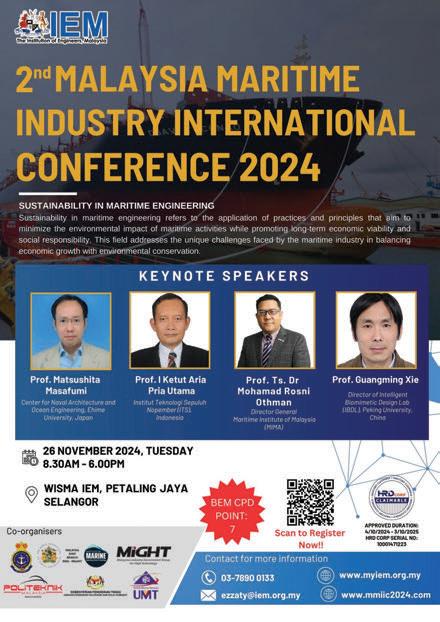
84308 MOHAMAD IZHAM
SHAH BIN HAMDAN BE HONS (UTM) (MECHANICAL, 2019)
86122 MOHAMMAD FAHRUL NIZAM BIN SUHAIMI BE HONS (UTHM) (MECHANICAL, 2019)
90801 MOHAMMAD SYAHIR BIN SAZALI BE HONS (UTP) (MECHANICAL, 2019)
77623 MOHD HELMI BIN RASHID BE HONS (UNIMAS) (MECHANICAL & MANUFACTGURING, 2018)
80013 MUHAMMAD ARIF BIN LUKEMAN @ OTHMAN BE HONS (UNITEN) (MECHANICAL, 2019)
94472 MUHAMMAD ARSYAD BIN AZIZI BE HONS (UKM) (MECHANICAL, 2021)
74671 MUHAMMED MUSTAQIM BIN ROSLY BE HONS (UiTM) (MECHANICAL, 2019)
88538 SZE CHEE SHIANG BE HONS (UTS) (MECHANICAL, 2019)
97047 TAN YIAW CHONG BE HONS (KOLEJ UNIVERSITI TUN HUSSEIN ONN) (MECHANICAL, 2020)
107439 VOON WU QIAN, EDEN BE HONS (SWINBURNE) (MECHANICAL, 2022)
KEJURUTERAAN MEKATRONIK
88588 CHEW JIE CHYEAN BE HONS (A.P.U) (MECHATRONICS, 2020)
97003 LEE JIA FEI BE HONS (TARC) (MECHATRONICS, 2020)
62114 MUHAMMAD AWAIS BIN FAROOQI BE HONS (APU) (MECHATRONIC, 2013)
85166 NURFARAH DIANA BINTI MOHD RIDZUAN TAN BE HONS (USM) (MECHATRONIC, 2019)
KEJURUTERAAN PEMBUATAN
102761 HARRESH A/L ANMPALAGAN BE HONS (UTeM) (MANUFACTURING, 2022)
86918 NURSAHIRAH BINTI ZAKARIA BE HONS (UKM) (MANUFACTURING, 2016)
PERMOHONAN MENJADI AHLI SISWAZAH No. Ahli Nama Kelayakan
KEJURUTERAAN AEROANGKASA
124135 JAYA UGIPRASHAANT A/L RAVINDREN BSc HONS (IOWA STATE UNI. OF SCIENCE & TECHNOLOGY) (AEROSPACE, 2020)
123857 JOSEPH AROKIASAMY CAAM (DCAM PART 66 CATEGORY C HOLDER) (AIRCRAFT, 2021)
124134 SULAIMAN BIN KAMARULAZIZI BE HONS (UPM) (AEROSPACE, 2008)
123852 YUGENDHRAN A/L KANASON CAAM (DCAM PART 66 CATEGORY C HOLDER) (AIRCRAFT, 2022) MBA (CARDIFF METROPOLITAN UNI.) (2018)
KEJURUTERAAN ALAM SEKITAR
124681 ASWARYA A/P PANIR CHELVAM BE HONS (UNIMAP) (ENVIRONMENTAL, 2017)
124120 NGAN CHUN SANG BE HONS (UM) (ENVIRONMENTAL, 2019)
KEJURUTERAAN AWAM
124712 AHMAD FAIZ BIN CHAYED BE HONS (UPNM) (CIVIL, 2012)
124112 AHMAD HAZWAN BIN ABDUL MUAAIS BE HONS (UTP) (CIVIL, 2011)
123878 AHMAD MUHSEEN FIRDAUS BIN MOHD FIRDAUS BE HONS (UTP) (CIVIL, 2020) MSc (USM) (CIVIL, 2023)
124660 AMOS WONG SHENG MIN BE HONS (CURTIN) (CIVIL & CONSTRUCTION, 2020)
124691 ANAND RYAN THURAIRAJAH BE HONS (UMS) (CIVIL, 2021)
124669 CHAI CHEE YONG BE HONS (BRADFORD) (CIVIL & STRUCTURAL, 2003) MSc (NEWCASTLE UPON TYNE UNI.) (GEOTECHNICAL, 2014)
124666 CHEW HUI KIAT, JORDAN BE HONS (UMP) (CIVIL, 2023)
123655 CHIN JOON FUI BE (UMP) (CIVIL, 2013)
124659 CHIN ZHAO DA, BENJAMIN MSc (COVENTRY.UNI) (CIVIL, 2019)
124695 CHONG SENG FAH BE HONS (INTI INTERNATIONAL UNI.) (CIVIL, 2015)
124670 CHUA SUANG THENG BE HONS (UNIMAP) (CIVIL, 2020)
123882 CHUNG WAI LIAM BE (UTP) (CIVIL, 2003)
123874 DANELLE LEEZONG JINIVON BE HONS (UMS) (CIVIL, 2021)
124156 DING KEN HAN, JOEL BE HONS (SWINBURNE) (CIVIL, 2022)
124679 DR. CHAN YON SIN BE HONS (UM) (MECHANICAL, 2018) PhD (MONASH) (MECHANICAL, 2023)
123858 Dr. LEE YONG SIANG BE HONS (UNIMAS) (CIVIL, 2013) PhD (USM) (CIVIL, 2020)
124155 DR. NORHANA BINTI ABDUL RAHMAN BE HONS (UiTM) (CIVIL, 2010) ME (UiTM) (CIVIL, 2012) PHD (UiTM) (CIVIL, 2019)
123910 EU CHAI NIE BE HONS (UTM) (CIVIL, 2022)
124674 FU CHYN NUM BE HONS (UTAR) (CIVIL, 2016)
124729 GOH CHUNG WEI BE HONS (UTAR) (CIVIL, 2022)
124713 HAJJAR BINTI HUSEIN BE HONS (UMP) (CIVIL, 2016)
124107 HARIGARAN A/L SUPERAMANIAM BE HONS (UNIMAP) (CIVIL, 2019)
123909 HENG WEI KIONG, ROBERT BE HONS (UTM) (CIVIL, 2005) MSc (UTM) (CONSTRUCTION CONTRACT MANAGEMENT, 2010)
123907 HEW CHOON YOW BE HONS (UCSI) (CIVIL, 2019)
124694 HO PEI CHI BE HONS (INTI. INTERNATIONAL UNI.) (CIVIL, 2023)
124108 HO PIN SIN BE HONS (UPM) (CIVIL, 2014)
123883 ISMAIL BIN ALI BE (UTM) (CIVIL, 1996)
123871 KHADIJAH BINTI YUSOFF BE HONS (UTM) (CIVIL, 2022)
124661 KHOMISAJIE BIN JAAFAR BE HONS (UiTM) (CIVIL, 2005)
123890 KUEH SYN YEE, CRYSTAL AVERY BE HONS (SWINBURNE) (CIVIL, 2022)
124150 KWONG KIEN CONG BE HONS (UNIMAP) (CIVILCONSTRUCTION, 2017) ME (UTM) (CIVIL, 2021)
124136 LAW LIK KIING BE HONS (MIU) (CIVIL, 2016)
124687 LEE MIN HUI BE HONS (HARBIN INSTITUTE OF TECHNOLOGY) (CIVIL, 2023)
124723 LEE SHU JUINN ME HONS (NOTTINGHAM) (CIVIL, 2023)
123860 LIEW CHIN LEE, KELVIN BE HONS (SWINBURNE) (CIVIL, 2021)
124708 LIEW YU VOON BE HONS (UNIMAS) (CIVIL, 2010)
124148 LIM YEONG SEONG BSc HONS (SOUTH DAKOTA STATE) (CIVIL, 1996)
123872 LOW AIK HONG BSc (I-SHOU) (CIVIL & ECOLOGICAL, 2019) MSc (I-SHOU) (CIVIL & ECOLOGICAL, 2020)
124100 MAI SARAH BINTI MOHD RAMLI BE HONS (UTM) (CIVIL, 2017)
124102 MOHAMAD SYAHIRAN BIN MOHAMAD RAFEE BE HONS (UTM) (CIVIL, 2016)
124115 MOHD AZWAN BIN SALLEH BE HONS (UiTM) (CIVIL, 2014) MSc (UiTM) (GEOTECHNICAL, 2017)
123899 MOHD KHAIRUL AKMAL BIN MD ZAHIR BE HONS (USM) (CIVIL, 2022)
124143 MUAID ABDULKAREEM ALNAZIR AHMED BE HONS (SWINBURNE) (CIVIL, 2013) MSc (UTAR) (SCIENCE, 2017)
124686 MUHAMAD SHARDIQ BIN MOHD SHUKRI
124700 MUHAMMAD AUF BIN
ABD. RAZAK
124140 MUHAMMAD FIKRY BIN RADZALI
123863 MUHAMMAD REZA BIN RAKLAN ALHADAD
124680 NAJWA MAISARAH BINTI MOHD RADOAN
123886 NASROL RAHMAN BIN ISMAIL
123898 NOR AINI BINTI MOHD YUNUS
BE HONS (UTM) (CIVIL, 2018)
ME (UTM) (FORENSICS, 2020)
BE HONS (UiTM) (CIVIL, 2021)
BE HONS (USM) (CIVIL, 2014)
BE HONS (UTM) (CIVIL, 2022)
BE HONS (UMP) (CIVIL, 2022)
BE HONS (UMP) (CIVIL, 2022)
BE HONS (UTM) (CIVIL, 2012)
124104 NOR DIANA BINTI SAMSURI BE HONS (CARDIFF) (CIVIL, 2014) MSc (SURVEY) (INFRASTRUCTURE & MANAGEMENT, 2016)
124721 NOR IMRAN BIN NOR AZLAN BE HONS (UTHM) (CIVIL, 2019)
124677 NORHASNIYATI BINTI MAT HUSSIN BE HONS (UNITEN) (CIVIL, 2014)
124153 NUR AMIRA BINTI MOHD ANUAR
HONS (UTM) (CIVIL, 2016) ME (UTM) (GEOTECHNICS, 2021)
124101 NUR AMIRUL AINA BINTI AB RAHMAN BE HONS (UTM) (CIVIL, 2021)
123912 NUR ANIZA BINTI BAKAR BE HONS (UiTM) (CIVIL, 2010)
123888 NUR AZURA BINTI CHE MAT SALWI BE HONS (UiTM) (CIVIL, 2021)
123903 NUR HAIZAN BINTI ALIAS BE HONS (UMP) (CIVIL, 2018)
123900 NURFARRAH AIN BINTI SHAMSUDDIN BE HONS (UITM) (CIVIL, 2012)
124676 NURLISA FAIZZARA BINTI MOHD RASHID BE HONS (UiTM) (CIVIL, 2018)
123868 PAVIN A/L RAVI BE HONS (UKM) (CIVIL, 2021)
124707 RAJDEEP SINGH A/L RANJIT SINGH BE HONS (UCSI) (CIVIL, 2016)
123864 RICKEY A/L SANTHANASAMY
124724 ROBIN ANAK PETER EMPANG MALANG
123880 SARNIYA A/P KESAVALOO
124154 SHARIFAH 'ATIKAH BINTI SYED BASHIR
124138 SIEW WEI CHING
123896 SITI NAJIHAH BINTI YAAKUP
124728 SITI SAKINAH BINTI SABRI
123861 SITI SYAFATIN NAJIHAH BINTI MOHD TALIB
124130 SOO XIAO CHIANG, VINCENT
123876 SUZALINNI BINTI SULAIMAN BE HONS (USM) (CIVIL, 1997)
123893 SUZLYANA MARHAIN BINTI MASIZAN BE HONS (UNITEN) (CIVIL, 2021)
124114 TAN JING NING ME HONS (NOTTINGHAM) (CIVIL, 2018)
124699 TAN KAH BENG BE HONS (USM) (CIVIL, 2012)
123866 TAN THIAN ZE, DANIEL ME HONS (UNI. OF LEEDS) (CIVIL, 2023)
124693 TANG NGA LIN, SALLY BE HONS (UMS) (CIVIL, 2012)
124672 TSANG LI XIN BE (HARBIN INSITTUTE TECH.) (CIVIL, 2021)
124671 TZE TUNG TAN BE (MELBOURNE UNI.) (ENVIRONMENTS, 2016) ME (MELBOURNE UNI.) (CIVIL WITH BUSINESS, 2018)
124697 WEE KANG XIANG, JONATHAN BE HONS (UNIMAS) (CIVIL, 2012)
124125 WONG JING QUN BE HONS (INTI.INTERNATIONAL UNI. ) (CIVIL, 2023)
124110 WONG JIUN HAO BE HONS (UCTS) (CIVIL, 2021)
124682 WONG REX ZAU BE HONS (SOUTH CHINA UNI. OF TECHNOLOGY) (CIVIL, 2021)
123879 WONG SU ANN ME HONS (NOTTINGHAM) (CIVIL, 2023)
123892 WONG ZHENG HAO, MELVIN BE (QUEENSLAND) (CIVIL & CONSTRUCTION, 2016)
124727 WONG ZI HAO BE HONS (UTP) (CIVIL, 2019)
124705 LIM CHEN YOONG BE HONS (UNSW) (CIVIL & ARCHITECTURE, 2021)
124149 PNG YIK SZE, EMILY BE HONS (SWINBURNE) (CIVIL, 2022)
124718 TUNG ZHI XUAN BE HONS (UTM) (CIVIL, 2022)
124720 ZAKI BIN ZULKIFLI BE HONS (UTM) (CIVIL, 2022)
KEJURUTERAAN BIOMEDIKAL
124133 DR. MOHD RIDUAN BIN MOHAMAD BE HONS (UM) (BIOMEDICAL, 2008) ME (UM) (BIOMEDICAL, 2011) PhD (STRATHCLYDE) (BIOMEDICAL, 2016)
KEJURUTERAAN ELEKTRIKAL
124684 AHMAD FADHIL BIN YAHYA BE HONS (UTM) (ELECTRICAL, 2018)
124158 AHMAD SYARYEL BIN AHMAD SHAH BE HONS (UMS) (ELECTRICAL & ELECTRONICS, 2008)
124701 AIMAN HAQEEM BIN ALIAS BE HONS (UNITEN) (ELECTRICAL POWER, 2023)
116239 CH'NG CHEE WEI BE HONS (CURTIN) (ELECRTICAL & ELECTRONIC, 2023)
123894 CHOO JIA YEN BE HONS (SWINBURNE) (ELECTRICAL & ELECTRONIC, 2020)
123869 CHUNG KWOK CHOONG, AERON BE HONS (UTAR) (ELECTRICAL & ELECTRONIC, 2016)
124151 DR. TAN SWEE TIAM BE (NANYANG TECHNOLOGICAL) (ELECTRICAL & ELECTRONIC, 2003) PhD (NAMYANG TECHNOLOGICAL UNI.) (ELECTRICAL & ELECTRONIC, 2007)
124146 HEW JUN HENG BE (DUNDALK INSTITUTE OF TECHNOLOGY) (ELECTRICAL & ELECTRONIC SYSTEMS, 2017) MSc (LEEDS) (ELECTRICAL & RENEWABLE ENERGY SYSTEMS, 2020)
123875 HO WAN CHUAN, PATRICK BE HONS (UTAR) (ELECTRICAL & ELECTRONICS, 2009) MSc (NOTTINGHAM) (ELECTRONIC COMMUNICATIONS & COMPUTER, 2013)
124106 IFFAH SYAHFINA BINTI ABDUL RAZAK BSc (WESTERN ONTARIO) (ELECTRICAL, 2021)
124099 INDIRAN A/L KAMALAN BE HONS (MMU) (ELECTRONICS, 2011)
124141 KENTHRA KANNAN A/L VARATHARAJAN BE HONS (UNITEN) (ELECTRICAL POWER ENGINEERING, 2022)
124127 MOHAMAD SYAFIQ BIN ABDULLAH BE HONS (UiTM) (ELECTRICAL & ELECTRONIC, 2017)
124678 MOHD FARID BIN MOHD ADNAN BE HONS (UNIMAP) (ELECTRICAL SYSTEMS, 2014)
124119 MUHAMMAD IKMAL BIN MOHD SAED BE HONS (UPNM) (ELECTRICAL & ELECTRONIC, 2019)
124683 MUHD FIKRI BIN OMAR BE HONS (UNITEN) (ELECTRICAL & ELECTRONICS, 2012)
HONS (UTP) (CIVIL, 2020)
HONS (UTM) (CIVIL, 2013)
HONS (UNITEN) (CIVIL, 2017)
HONS (UITM) (CIVIL, 2021)
HONS (NOTTINGHAM) (CIVIL, 2021)
HONS (UMP) (CIVIL, 2018)
HONS (UKM) (CIVIL, 2021)
HONS (UPM) (CIVIL, 2018)
HONS (UTAR) (CIVIL, 2017)
124157 NGU SIE YOONG, ERIC BE HONS (UTP) (ELECTRICAL & ELECTRONICS, 2018)
124142 NOR ASYIKIN BINTI ROS AZMAN BE HONS (UNIMAP) (ELECTRICAL, 2021)
124726 SAFFUANDI BIN JUNAIDI BE HONS (UNISEL) (ELECTRICAL, 2022)
124662 SHAZRAIN ASYRAF BIN SUHAIMI BE HONS (UiTM) (ELECRTICAL, 2016)
124689 TAN JIN HUI, PATRICK BE HONS (UNITEN) (ELECTRICAL & ELECTRONIC, 2008)
123905 TEH JIA KEE BE HONS (UTAR) (ELECTRICAL & ELECTRONIC, 2021) ME (UTAR) (ELECTRICAL, 2023)
124121 VIGNES RAO A/L SUBRAMANIAM BE HONS (UNITEN) (ELECTRICAL & ELECTRONIC, 2019)
123908 WAN ZULKIFLI BIN WAN IBRAHIM BE HONS (UTM) (ELECTRICAL, 2019)
124688 WONG KING UNG, FRANCIS BE HONS (UKM) (ELECTRICAL & ELECTRONICS, 2009)
123902 GAN JIAN JIE BE HONS (UKM) (ELECTRICAL & ELECTRONIC, 2021)
123887 MOHAMAD BIN DURI BE (UTM) (ELECTRICAL, 1991)
123891 MUHAMAD FIRDAUS
BIN SHAHARUDDIN BE HONS (UNIKL) (ELECTRICAL, 2019)
124137 NOOR HIDAYAH BINTI SHAARI BE HONS (UNIMAP) (ELECTRICAL, 2021)
123901 NORFADILAH BINTI
ZULKEFLI BE (UMP) (ELECTRICALPOWER SYSTEMS, 2012)
123889 NUR FARAHIN BINTI
ZULKARNAIN BE HONS (UTP) (ELECTRICAL & ELECTRONICS, 2015) MSc (UTP) (ELECTRICAL & ELECTRONICS, 2018)
124145 TING WAN SHIN BE HONS (SWINBURNE) (ELECTRICAL & ELECTRONIC, 2013)
KEJURUTERAAN ELEKTRONIK
124111 CHEW POH KANG BE HONS (SOUTHERN UNI. COLLEGE) (ELECTRONIC, 2023)
123895 KAMALESWARAN A/L SELANTHAMILAN BE HONS (UNITEN) (ELECTRICAL & ELECTRONICS, 2011)
124715 LIM YEONG WEY BE HONS (UTAR) (ELECTRONIC, 2023)
124716 LING KAH HONG, ERIC BE HONS (UTAR) (ELECTRONIC, 2023)
124123 NEO EN XIN BE HONS (UM) (BIOMEDICAL, 2021)
KEJURUTERAAN KIMIA
124164 BOH CHUANG JYHE BE HONS (UTAR) (PETROCHEMICAL, 2023)
124162 CHAN JUN QUAN BE HONS (UTAR) (PETROCHEMICAL, 2023)
124161 EWE WEI NIAN BE HONS (UTAR) (PETROCHEMICAL, 2023)
124160 LIAW SI JIAN BE HONS (UTAR) (PETROCHEMICAL, 2023)
124668 MOHAMAD SAIFULLAH BIN ABD HAMID BE HONS (UiTM) (CHEMICAL, 2021)
124126 NURUL NABILA BINTI ABDULLAH KASSIM BE HONS (UiTM) (CHEMICAL & PROCESS, 2017)
124719 TA SU QING, CELINE ME HONS (NOTTINGHAM) (CHEMICAL & ENVIRONMENTAL, 2023)
124128 TAN RU QIAN, GLADYS BE HONS (SWINBURNE) (CHEMICAL, 2023)
124159 WONG YI XUAN BE HONS (UTAR) (PETROCHEMICAL, 2023)
124710 AIDIL MOKHTARUDDIN BIN MOHD TARMIZI BE HONS (MASSEY) (CHEMICAL & BIOPROCESS, 2019) BE HONS (UNIKL) (CHEMICAL, 2016)
124706 ANG JIA CHUN ME HONS (NOTTINGHAM) (CHEMICAL, 2022)
124717 CHUA SIEW HWEE BE HONS (UTAR) (CHEMICAL, 2023)
124692 DR. LEE SIEW PEI BE HONS (UTM) (CHEMICALBIOPROCESS, 2009) PhD (UTM) (CHEMICAL, 2020)
KEJURUTERAAN MARIN
123904 AZIZAN BIN ISMAIL COC MARINE CLASS 1 (AKADEMI LAUT MALAYSIA) (2003)
124673 DHARMENTHRAN A/L SANNASY COC CLASS 1 (AKADEMI TENTERA LAUT) (2018)
KEJURUTERAAN MEKANIKAL
123911 AHMAD FADHLIN BIN AHMAD JAAFAR BSc (HANYANG) (MECHANICAL, 2023)
124147 AL AMEER BIN MASHAL BE HONS (UNITEN) (MECHANICAL, 2008)
124124 AMIRAH HUSNA BINTI MOHD SALEH BE HONS (UNITEN) (MECHANICAL, 2022)
124122 CALVIN SOO SHUI ZHEN BE HONS (TAYLOR'S) (MECHANICAL, 2021)
124711 CHONG JIN YANG BE HONS (UNITEN) (MECHANICAL, 2023)
124664 DAVANNENDRAN CHANDRAN BE HONS (NOTTINGHAM) (MECHANICAL, 2010) MSc (UTM) (MECHANICAL, 2023) PhD (NOTTINGHAM) (MECHANICAL, 2017)
124702 DHIVENDRA A/L VESVANATHAN BE HONS (UTP) (PETROLEUM, 2017)
124105 GAUTHEMAN KURUP
A/L RAVI BE HONS (UOW-KDU COLLEGE) (MECHANICAL, 2020)
124113 GRANNIL DING SIMON A/L GABRIEL PETER BE HONS (UNITEN) (MECHANICAL, 2018)
124129 HINTHUJAH SUNTHARAM BE HONS (MIU) (MECHANICAL, 2019)
123877 HUANG SHOUREN, JEREMY BE HONS (SWINBURNE) (MECHANICAL, 2021)
123856 JARETH ANAK JACK BE HONS (SWINBURNE) (MECHANICAL, 2020)
124132 KHAIZURAN IZZAT BIN KHAIRUDDIN BE HONS (UTP) (MECHANICAL, 2019)
124709 KUMARAVELU A/L SANMUGAM BE HONS (USM) (MECHANICAL, 2010)
123867 LIM CHEN CHENG, ALISTER BE HONS (MMU) (MECHANICAL, 2016)
124698 MOHAMAD ALIF BIN OMAR BE HONS (UNITEN) (MECHANICAL, 2022)
124704 MOHAMAD HAFIZ IKHWAN BIN MOHD AMIR BE HONS (UTeM) (MECHANICAL - AUTOMOTIVE, 2014) MSc (UPNM) (MECHANICAL, 2017)
123854 MOHAMAD SYAZWAN BIN MOHD ZAIN BE HONS (UM) (MECHANICAL, 2020)
124165 MOHD AL FADIL BIN MOHD SALLEH BE HONS (UTM) (MECHANICAL, 2003)
123853 MUHAMAD AMINUDIN BIN CHE MANSOR BE HONS (UTM) (MECHANICAL, 2018)
123859 MUHAMAD SUWAID BIN SAAD BE HONS (ITM) (MECHANICAL, 1998)
123906 MUHAMMAD DANIAL BIN SULAIMAN ME HONS (SEGI) (MECHANICAL, 2012) ME HONS (SHEFFIELD) (MECHANICAL, 2015)
123855 MUHAMMAD FIRZLAN BIN AZILAN BE HONS (UTM) (MECHANICAL PRECISION, 2020)
124696 NABIL IMRAN BIN BASRI JOHAN JEET BE HONS (WOLLONGONG) (MECHANICAL, 2020)
124725 NGO CHIN CHUAN, ALEXANDER BE HONS (UTAR) (MECHANICAL, 2009)
124103 NOLIA BINTI HARUDIN BE HONS (UTM) (MECHANICALINDUSTRIAL, 2008)
124690 NUR HAPINDER BINTI ABDULLAH BE HONS (UTAR) (MECHANICAL, 2021)
124139 NUR MAISARA BINTI
MOHAMED YUSOFF BE HONS (USM) (MECHANICAL, 2019)
124131 NURUL FATEHA BINTI ABD KADIR BE HONS (UNITEN) (MECHANICAL, 2017)
123881 ONG SHU ZHEN BE HONS (SUNDERLAND) (MECHANICAL, 2016) ME (UM) (MECHANICAL, 2022)
124144 TAN KOK JIN, JONATHAN BE HONS (TAYLOR'S) (MECHANICAL, 2022)
124117 TENGKU MOHAMMED HANAFI BIN TENGKU ABU BAKAR BE HONS (KOLEJ UNIVERSITI TUN HUSSEIN ONN) (MECHANICAL, 2006)
123873 THAYALAN A/L GUNASEKRAN BE HONS (UNITEN) (MECHANICAL, 2016)
124675 WONG JIA YI, JOSHUA BE HONS (USM) (MECHANICAL, 2018)
124703 YEN HAN WAY BE HONS (TASMANIA) (MECHANICAL, 2022)
123897 ZIEERWAN BIN ZAINAL BE HONS (UTP) (MECHANICAL, 2011)
KEJURUTERAAN MEKATRONIK
124118 CHAN CHAO SHIUNG BE HONS (UMP) (MECHATRONICS, 2016)
124663 LEE JIA YANG, NICHOLAS BE HONS (MONASH) (MECHATRONICS, 2020)
123862 SIM MENG HONG BE HONS (SWINBURNE) (ROBOTICS & MECHATRONICS, 2011)
123884 Dr. RABIATULADAWIAH BINTI ABU HANIFAH BE HONS (IIUM) (MECHATRONICS, 2011) MSc (IIUM) (MECHATRONICS, 2015) PhD (IIUM) (ENGINEERING, 2020)
123870 MUHAMMAD NUR AMIN BIN HAMID BE HONS (UNIMAP) (MECHATRONIC, 2018)
KEJURUTERAAN NUKLIER
124665 ILYAS MOHD RUSLI BE HONS (UTM) (NUCLEAR, 2020)
KEJURUTERAAN PEMBUATAN
123885 GUNALAN A/L ILANGOVEN BE HONS (UMP) (MANUFACTURING, 2020)
124109 MOHD FAIZ BIN ABDUL AZIZ BE (MELBOURNE) (MECHANICAL & MANUFACTURING, 2013)
124685 MUHAMMAD FARHAN BIN KHUTUBU RUBBANI BE HONS (IUT TOULUN VAR, UNIVERSITE DE TOULAN) (MECHANICAL & MANUFACTURING, 2017) ME (UTBM) (ERGONOMICS, DESIGN & MECHANICAL, 2020)
124116 NURUL AIDA MOHD MORTAR BE HONS (UNIMAP) (MANUFACTURING, 2015) MSc (UNIMAP) (MATERIALS, 2019)
124722 SHAFINAZ BINTI DAUD BE HONS (UKM) (MANUFACTURING, 2018)
124714 TING KAI ZIN BE HONS (UTAR) (INDUSTRIAL, 2023)
KEJURUTERAAN PERLOMBONGAN
123865 CHIONG ZHAO JIE, STANLEY BE HONS (QUEENSLAND) (MINING AND GEOTECHNICAL, 2022)
KEJURUTERAAN PETROLEUM
124667 NAQIB NUR IMAN BIN ZAKARIA BE HONS (UNSW) (PETROLEUM, 2020)
KEJURUTERAAN SUMBER MINERAL
124152 MUHAMMAD DZAFIR BIN MOHD ZAILANI BE HONS (USM) (MINERAL RESOURCES, 2017)
PERMOHONAN KEPADA AHLI SISWAZAH TEKNOLOGIS KEJURUTERAAN
No. Ahli Nama Kelayakan
KEJURUTERAAN AWAM
123946 CHIENG KIONG UNG BSc (UTM) (CONSTRUCTION, 2008)
KEJURUTERAAN ELEKTRIKAL
123922 MUHAMMAD AFIQ BIN RASLAN BTECH HONS (UTEM) (INDUSTRIAL POWER, 2019)
KEJURUTERAAN INTEGRATED
124731 SIA JIA HAO DCAM PART 66 B1 HOLDER
KEJURUTERAAN MEKANIKAL
123947 TRACY GIOVINA ANAK UNJA BE HONS (SUNDERLAND,UK) (MECHANICAL, 2015)
PERMOHONAN MENJADI AHLI 'INCORPORATED' No. Ahli Nama Kelayakan
KEJURUTERAAN AWAM
123851 CYNTHIA DEBBY HERIYANI B.E. (UNIVERSITAS ATMA JAYA YOGYAKARTA) (CIVIL, 2017)
KEJURUTERAAN PEMBINAAN
123949 LING SEOW LING B.TECH.HONS. (IUKL) (CONSTRUCTION MANAGEMENT, 2019)
KEJURUTERAAN ELEKTRONIK
123948 LOGANATHAN A/L SIVAPRAGASAM B.E.HONS. (LIVERPOOL JOHN MOORES) (ELECTRONIC & CONTROL SYSTEM, 2010)
KEJURUTERAAN ELEKTRIKAL
124415 CHUAN DEIK SHAWN B.E. TECH. HONS. (UNIMAP) (ELECTRICAL INDUSTRIAL POWER, 2021)
PERMOHONAN MENJADI AHLI 'ASSOCIATE' No. Ahli Nama Kelayakan
KEJURUTERAAN ELEKTRONIK
123951 TAY KENG YUE DIP. (TUNKU ABDUL RAHMAN COLL) (ELECTRONIC, 2003)
KEJURUTERAAN MEKANIKAL
124413 FOO SIANG MING DIP. (POLI KUCHING, SARAWAK) (MECHANICAL, 2006)
124414 MOHAMMED ABDULLAH DIP. (SHANMUGA POLYTECHNIC,THANJAVUR) (MECHANICAL, 2003)
PERMOHONAN MENJADI AHLI 'AFFILIATE' No. Ahli Nama Kelayakan
KEJURUTERAAN KIMIA
123950 TEO CHEE LOONG BSc (UTM)(INDUSTRIAL BIOLOGY, 2012) PhD (UTM) (BIOPROCESS ENG, 2015)
ADMISSION TO THE GRADE OF STUDENT MEMBER No. Ahli Nama Universiti
KEJURUTERAAN ALAM SEKITAR
124453 CH'NG PEI WEN UTAR KAMPAR
123843 DARIEN LIM JING XUAN UTAR KAMPAR
KEJURUTERAAN AWAM
124630 ABDURRAHMAN ATIQULLAH BIN MOHD MAHYILDDIN PUO
123773 ABRAHAM TSUYOSHI ANAK LAINUS UNIMAS
124325 AHMAD FAIZ ZUHAIREE BIN AHMAD FAKHRUL-DIN UTHM PAGOH
124631 AHMAD HARITH JAFRI BIN AHMAD JAFRI PUO
124620 AHMAD RAFIQ KAMIL BIN RAZALI PUO
124629 AHMAD ZUFRI BIN ZAINUDIN PUO
124562 AIMAN ASYRAAF BIN ANUAR UiTM PERMATANG PAUH
124356 AKMAL IKHWAN FIKRI BIN ROSLAN UTHM PAGOH
124231 ALBERT HII WEI JIAN UTM
124196 AN HUI YEE UTM
124183 ANG WEI LIANG UTM
124223 ANG ZHONG XIAM UTM
124486 ANUSHRI A/P BATUMANATHAN UTM
123804 ANWAR JEFRI BIN SUPANDI UNISEL
124621 ARLENE MICHELLE ANDREWMUS PUO
123772 AYU MAISARA BINTI SAMARAYAU @ LATIP UNIMAS
124625 AZHAD AZZAD BIN AZIZAN PUO
124335 BUKALENDHI A/L THARMANESAN UTHM PAGOH
124087 CALVIN KHO KA YIN UPM
124624 CARL WAINER BAILON PUO
124246 CHANG SUAN NYEE UTM
124255 CHIA YIAN YE UTM
124064 CHIN MAN WEI UM
123801 DAYANG NUR SYUHADA BINTI ABDUL AZIZ UTM
124177 DENNIS WONG TECK WEI UTM
124364 DHURGASHINI DEWI A/P BALA UTHM PAGOH
124198 DYLAN TAY WANG AN UTM
124431 ELIEZER NEVALL ANTHONY UMS
124465 EMILYNN KRISTINA LO UTM
124593 FATIN NAJIHAH BINTI MUHAMMAD FERDAUS PUO
124430 FLORENCE LIM JIA SHIAN UTM
124071 HARIS KUMAR A/L PARAMASIVAM UNISEL
124256 HENG QIAN WEN UTM
124375 IELY MAISARA BINTI IBRAHIM UTHM PAGOH
124476 JAMES MICHAEL CHU HERNG TECK UTM
124213 JESSY ANG EE CHYI UTM
124617 JIVENTHRAN DR A/L DEVADASAN PUO
124069 JONATHAN YAP ZIQIN IMPERIAL COLLEGE LONDON
123842 KANKANALA HARSHITHA REDDY UCSI 124194 KEK JIA CHING UTM 124592 KESAVARMAN A/L GUNARAJAN PUO 124227 KURBY HIU CHEN KANG UTM 124493 KWEK YONG QI UTM 123825 LAWANIA D/O SELORAGE UTM 123831 LEE CHEE YANG UTP 124190 LEE CHUN HOE UTM 124504 LEE SAM WAI UTM
LIEW QI FONG UTM
124601 SIVANNESWARAN A/L ELLAKOVAN
124189 TAN KAR HUI
TENG KOK MING
124215 THIVNASHDEWI A/P MUTHUSAMY
123841 TIEW KAO CHEN
124400 VEDDHESH A/L KANAPATHY
124332 VEEMAL A/L SURESH
124606 WAN AMEERUL EIMAN BIN WAN AINOL AMIR
124248 WILLIAM ONG JUN JIE
123769 WONG TUNG CHI, SIMON
124208 WONG VOON PING
124220 WONG ZI YI
124626 YAP CAI FONG
124519 YEOH CHUN HUNG
124498 YONG HOW KING
124057 YOOGAN A/L PUSPANATHAN
123768 ZAAFIRA HAZELL BINTI MOHAMMAD JEFFERY
124079 ZAIDEL IKHWAN BIN ZAINAL ABIDIN
124073 ZALFEERA SOFEA BT ZAINURMALLAL
KEJURUTERAAN BAHAN 124060 HAMZAH ABDUL MAJID
KEJURUTERAAN BIO-PERUBATAN
ANG XIN YI
ANGEL LEE YEE ZHEN
CHIN WUN
EMILY SOH JING YUAN
PAGOH
MUHAMMAD AFIQ IRHAM BIN ABDULLAH UTM
MUHAMMAD AKMAL BIN JAILANI PUO 124089 MUHAMMAD AMMAR BIN NOR MOHAMAD ZAZALI UiTM SHAH ALAM
124627 MUHAMMAD ASYRAF BIN MOHD ZAINI PUO
124597 MUHAMMAD FAIZ BIN RAMLI PUO
124065 MUHAMMAD FIRDAUS BIN ZULKIFLI UM 124326 MUHAMMAD HAKIMI BIN MOHD HELMI UTHM PAGOH
124611 MUHAMMAD IQMAL ALIF BIN ARSHAD PUO
124616 MUHAMMAD LUQMAN HAKIM BIN ZAN PUO
124434 MUHAMMAD MU'AZ BIN MAZLAN UTM
123817 MUHAMMAD SAZWAN EMIR BIN MAT SAAD UiTM SHAH ALAM
124377 MUHAMMAD SHARIF BIN MOHAMED MUBARAK ALI UTHM PAGOH
124602 MUHAMMAD SYAFIQ AIMAN BIN RAMLAN PUO 124598 MUHAMMAD SYAZWAN HAFIY BIN NOOR HISYAM PUO
124360 MUHAMMAD TAUFIQ BIN ABU BAKAR UTHM PAGOH 124614 MUHAMMAD THALHA BIN HAMDAN PUO 124605 MUHAMMAD ZHARFAN BIN KAMARUDIN PUO
124376 NASYA IZZANI BINTI MOHD YUSOF UTHM PAGOH 124451 NELSON NAWIN ANAK MAJANG UTM SPACE 124061 NG SHE CHIN UM 124511 NG XUN YI UTM
123957 NICHOLAS CHIENG KAI LIANG UTM 124612 NIRSHAAN SERVAI A/L BAALACHANTHER PUO
124383 NUR AISYAH JAMILAH BINTI ALIAS UTHM PAGOH
124527 NUR AMALIN QISTINA BINTI ABDULLAH UTM 124603 NUR ARISYA AMANI BINTI AZMI PUO
124619 NUR FATIMAH ADRIEANA BINTI NORALIAS PUO 124088 NUR SYAMIMI BINTI NORISMAN UiTM SHAH ALAM
124596 NUR SYAZANA BINTI SHAMSURI PUO 123965 NURSYAAKIRAH BINTI AMIR UTM
TOH KA PENG
124532 UGENDRABABU A/L NOOKARAJU UTM
KEJURUTERAAN ELEKTRIKAL 123829 ABDUL KARAF BIN MAT TAJUDIN UiTM SHAH ALAM
124392 AFIQ DANISH BIN ZALIMAN UTHM PAGOH
124346 AHMAD AQIL HAIKAL BIN MOHAMAD AZWAN UTHM PAGOH
123967 AHMAD AZIMIE ADHA BIN AHMAD ASHRAFF UiTM DUNGUN
124387 AHMAD FAHMI IMAN BIN NOR FADZIL UTHM PAGOH
123985 AHMAD NABIL BIN MD IDRIS PTSN 123836 AHMAD WILDAN BIN MUZAHA UiTM DUNGUN
124288 AINA BATRISYIA BINTI SAHRIN UTHM PAGOH 123814 AKHILESH NAIR A/L DEVAN UTM
123988 AKMAL HAZIQ BIN MOHD FAUZI PTSN 123941 ALVIN SOO QWAN ZHOU MONASH 124314 AMIRA HANI BINTI MOHD KHADZIR UTHM PAGOH 124570 AMIRUL ASYRAF BIN MOHD RAFI UiTM SA 124285 AMIRUL IMAN BIN MOHD AMIN UTHM PAGOH
124204
MUHAMMAD AFIQ BIN MOHAMMAD RAZIF UTHM PAGOH
MUHAMMAD AKMAL HAKIM BIN MD JAIS PTSN 124347 MUHAMMAD ALIFF DANIEL BIN MOHD AZHAR UTHM PAGOH
123992 MUHAMMAD AMIR AKMAL BIN MOKHTAR PTSN 124359 MUHAMMAD AMIRUL AQIL BIN AZMAN UTHM PAGOH 123997 MUHAMMAD AMMAR HARIDZ BIN YUHAFIZ PTSN
123780 MUHAMMAD ANAS BIN MOHD RUSDI UiTM SHAH ALAM
124590 MUHAMMAD ARIFUDDIN BIN ROSDIN UiTM SA 124355 MUHAMMAD AZRI HAIKAL BIN AZENAN UTHM PAGOH
124283 MUHAMMAD DANISH HAIQAL BIN AMRAN UTHM PAGOH
124547 MUHAMMAD DANISH QAYYIM BIN FAZLI UTM
123974 MUHAMMAD EZZAT IZZUDDIN BIN MOHAMMAD SUKRI PTSN
124368 MUHAMMAD FAIQ MUGHIS BIN MOHD JAIS UTHM PAGOH
124633 MUHAMMAD FAIZ BIN AZUKI UM
123993 MUHAMMAD FARIS BIN ABD LATIP PTSN
123989 MUHAMMAD FIKRI ALIMI BIN ISNAZLI PTSN
124319 MUHAMMAD FIRDAUS BIN MOHD ROSDIE UTHM PAGOH
124297 MUHAMMAD HAFIZ BIN ABD RAZAK UTHM PAGOH
124304 MUHAMMAD IDZHAM HAIRI BIN MOHD FADHIL HAJAZI UTHM PAGOH 124432 MUHAMMAD IHSAN BIN IDRUS UM 124318 MUHAMMAD IQBAL BIN ABDULLAH UTHM PAGOH 123977 MUHAMMAD KHAIR HAFIFI BIN MOHD KHAIRIL PTSN
124320 MUHAMMAD KHALIS BIN AZANFARIZAL UTHM PAGOH 123759 MUHAMMAD KHALISH BIN KHAIRUL ASMAN UNITEN
124349 MUHAMMAD LUQMAN BIN ISMAIL UTHM PAGOH
124327 MUHAMMAD NAFIS BIN ISMAIL UTHM PAGOH 123998 MUHAMMAD NAQIUDDIN BIN NASSHARUDDIN PTSN
124589 MUHAMMAD NAZMI BIN AZMAN UiTM PERMATANG PAUH
123986 MUHAMMAD SHAFIQ BIN SHAHRULNIZAN PTSN
124634 MUHAMMAD SHAHZUA BIN MOHD SHARAFIE UiTM DUNGUN
124428 MUHAMMAD SYAFFIQ AIMAN BIN SULAIMAN UiTM
124501 MUHAMMAD SYAFIQ FIRDAUS BIN MOHD SHABIR UTM
124373 MUHAMMAD YUSUF BIN SUKRI UTHM PAGOH
124343 MUHAMMAD ZULKARNAIN BIN JUNAIDI UTHM PAGOH
124369 MUTHISWRAN A/L JAYA SHANKAR UTHM PAGOH
124316 NADIAH NUR QISTINA BINTI ZULAINI UTHM PAGOH
123943 NG QIAO YAN MONASH
123939 NG SHIEN MING MONASH
124388 NOOR AWAN CHIK BIN NORZELI UTHM PAGOH
123835 NOR SAHASNA SYABILLA MOHAMAD IZLAN SAH UiTM DUNGUN
124639 NORFARHANIS BINTI NORHISHAM UiTM DUNGUN
123978 NUR AFIQAH BINTI AHMAD AZLI PTSN
124367 NUR AIN SHAHEERA BINTI ZAKARI @ AWANG UTHM PAGOH
124342 NUR AINA SYAFIQAH BINTI AZMI UTHM PAGOH
124313 NUR ALYA BATRISYA BINTI MOHAMMAD TARMIZI UTHM PAGOH
124353 NUR ASYILAH SYUQAIRAH BINTI LAURONG @ HARUN UTHM PAGOH
124334 NUR DINI DAYANA BINTI AHMAD KHOMEINI UTHM PAGOH
124078 NUR INSYIRAH BINTI MD ASMAWI UiTM DUNGUN
123983 NUR NADHIRAH BINTI MAT ZAIDI PTSN
124269 NURUL FATIHAH BINTI MOKHTARAZI UTHM PAGOH
124338 NURUL HUSNA ADILA BINTI IKRAM SYAH UTHM PAGOH
124289 NURUL IZZATI BINTI MOHD SHAHRIZAN UTHM PAGOH
124390 NURUL NABIHAH BINTI ASHAR UTHM PAGOH
124389 NURUL SAIYIDAH BINTI MOHD NIZAM UTHM PAGOH 124460 OOI JING YING UTM
OOI ZHEN WEI UTM
OOI ZHI XIAN UNiMAP
RABIATULADAWIYAH BINTI NOOR LATIF UTHM PAGOH
A/P SINNAKARUPAN UTHM PAGOH
BINTI WAN MADZLAN UTHM PAGOH
124587 WAN SADRUDDIN HAZIQ BIN WAN SUHAIMI UiTM SA 124067 WONG HONG LIEN UM 124479 YAN ZHENG SHEN UTM 124423 YOUNG ZULKHAIRY BIN YOUNG ZAIDEY UTM
KEJURUTERAAN ELEKTRIKAL & ELEKTRONIK 124021 AIMAN KHAIRFUL IKHWAN BIN SULAIMAN UiTM DUNGUN
123847 CALVIN JOHN JALONG UNIMAS
123767 CHING ZHEN YUAN UNIMAS 123766 CYPRIAN CORGEDO UNIMAS 124085 DANNY MUSTAQIM BIN MOHAMMED JAYRAMIE ENG SEGI
123777 HUONG YEW SIING, ROY UNIMAS 123779 MUHAMMAD SYUKUR BIN ABDUL RAHMAN UNIMAS
123765 MUHAMMAD ZAKWAN BIN SUHAIMEE UNIMAS 124354 MUHAMMAD ZARUL IRFAN BIN MOHD NASIR UTHM PAGOH
124055 NANDHANA SHANKARA A/L THAMIL SELVAN UMP
124086 NATALIE CHU WEN YI NOTTINGHAM MSIA
123778 NURHUSNA BINTI WAHID UNIMAS 123815 ONG ZHE XIAMEN 123784 SAIFUDDEEN WAEL MUHAMMAD UTM 124095 SAMUEL BENJAMIN MARENGO APU 124083 SHANTHI THANAPALAN SEGI
124446 SITI NOR ATIQAH BINTI MOHARAM UMS
123846 SUREKHA KARTHIGESU NANYANG TECH UNI
124091 TAN LIK FUN NOTTINGHAM MSIA 124074 WONG WENG TI TAYLOR'S UNI
AIDIAZLIN BIN MOHAMAD ARIFIN UTHM PAGOH
AQILAH BINTI ABD HALIM UTHM
MUHAMMAD SHAFIQ BIN MOHD KAMARULZAMAN UTHM PAGOH
124302 MUHAMMAD SYAZANI BIN ZAINI UTHM PAGOH 124268 NAVENKUMAR A/L SELVAM UTHM PAGOH 124212 NG CHIAN TUNG
SAMUEL LOW YU HANG
KEJURUTERAAN KIMIA 124221 ABDUL AMIR KHAN BIN NURUL RAHMAN
ABDUL HISHAM BIN SOBRI
AHMAD FAIZ BIN RAMELI
124340 AHMAD FAREEZ ZULHAQEEM BIN AHMAD ZAHADI
AHMED AQIL BIN MOHAMAD TAHA
AIDA SOLEHAH BT ISMAIL
124260 ALVIN OWEN MIHARIL
ALVYNE RENNO ANAK STEPHEN
AMISH NAIR
AMNI BINTI ABD MUTALIB
ANG YANG
AZRAI FAZLISHAM BIN AB HAMID
BATRISYIA ALIAH BINTI MUHAMAD AMIN
CEDRIC TEOH JUN XIAN
CHAN YEK FUNG
CHAN YI JIE
CHANG QING YIU
CHEN KE NEE
124536 CHEONG WEI XIN
124516 CHETSADA A/L ISOT
CHIN JO ANN
CHLOE BONG YUN JIE
CHONG XIAN ZHUANG
CHONG XIN JING
CHOY WAN YI
CHUA SHIRENE
DACHAINI MUTHALYAR A/P SUTHAKARAN
DARSHNI KUMARI A/P MOORUHAYA
DARSSHAN A/L RAMAN
DENNIS LEE WEN JIE
DONG CYEE YANN
E SHAO YUAN
ELVIRA KIU
GAN YEE CHIAN
PAGOH
UiTM BUKIT BESI
123790 MUHAMMAD ZULHILMI BIN MOHD IBRAHIM UTM
124054 NABILAH BINTI YUHASLIZE UiTM BUKIT BESI
124345 NADIA NATASHA BINTI AFANDI UTHM PAGOH
124466 NG CHEONG YI SUNWAY 124533 NG JING YEE UTM 124197 NGAN YI LING UTM
123830 NOOR A'IN SYAHIRAH BINTI NORZARIS UiTM BUKIT BESI 123774 NOR FARADIBA BINTI AHMAD UNIMAS
NORFITRIAH SHAKIRIN BINTI CHE HASSAN UiTM PERMATANG PAUH 124277 NUR FARAH ATHIRAH BINTI MOHD NOH UTHM PAGOH
NUR HUSNINA BATRISYIA BT ROSNI ZAMUDDIN SHAH UiTM BUKIT BESI 123945 NUR IRDINA IZZATI BINTI ZAKARIA UMP
NUR IZZATI SYAMIMI BINTI MOHAMAD AZMI UTHM PAGOH 123916 NUR SYAHIDA SYAFIQAH BINTI NORALIMI UiTM BUKIT BESI 124281 NUR SYAKINAH BINTI SABRI UTHM PAGOH 124041 NURDINA ADLINA BINTI MOHD SUZAIMI UiTM BUKIT BESI
124421 NURSHAMIMI AZIRA BINTI MASRAN UM 124282 NURUL AIN NATASAH BINTI ABDULLAH UTHM PAGOH 124303 NURUL NATASHAH BINTI MD SHAHROM UTHM PAGOH
124503 ONG HUI WEN UTM
123819 PAPICHAYA NG NOTTINGHAM MSIA
124311 PUTRI NURUL MISHAH BINTI SHAHJAHAN UTHM PAGOH
124294 RAJA NUR DALILAH BATRISYIA BINTI RAJA ZAINAL UTHM PAGOH
124429 RUTH TAY SOONG YI UTM
123937 SANJEEVAN RAVINDRAN MONASH
124287 SHAHIRAH NURAIN BINTI RAZALI UTHM PAGOH
124284 SITI AISHAH LIYANA BINTI ROSLEE UTHM PAGOH
123786 SITI ALFINA BINTI DARWIN @ DARWING UTM
123849 SITI HAJAR BINTI MOHD PODZI UNIMAS
124552 SO JIA XIN UTM
124252 STANLEY SOO TECK KEONG UTM
124467 TAA QI HANG SUNWAY 124232 TAI CHEE SHEN UTM 124217 TAM YEE BONG UTM
124167 TAN HOOI LING UTM
124435 TAN JING WEN UTM
124242 TAN WAN QI UTM
124439 TEH XIONG SIANG UTM
124209 TEOH SWEE TAT UTM
124494 THAANUSH A/L MURALY UTM 124382 THARESHINI A/P SUPRAMANIAM UTHM PAGOH 124296 THIVYA A/P TAMILVANAN UTHM PAGOH 123785 TING ZHI ZHANG, JOHN UTM 124455 TRESA AU WEN XIN SUNWAY
124251 TSAI JIA YUH UTM
124526 WAI CHUN KEN UTM
124492 WAN MUHAMMAD IRFAN BIN WAN SALEHUDIN UTM
124452 WONG YEN CHAI UTM
124449 YAP SIANG CHEE UTM
124458 YONG FUNG YEE UTM
124218 YONG ZHENG ZHAO UTM
KEJURUTERAAN KOMPUTER
124558 ARNOB RIZWAN AHMAD UTM
124096 GREGORY DYLAN SCOTT PANAGARY APU
123933 KOE RUI EN MONASH
124528 YAP EN THONG UTM
KEJURUTERAAN KOMUNIKASI
123782 TASNEEM BINTI SOFRI UNIMAP
KEJURUTERAAN MEKANIKAL
123822 ADLI ADHAM BIN ABDUL HAKIM UiTM BUKIT BESI
124076 ADRIEL WONG JENKIN TAYLOR'S UNI
124006 AHMAD ARMAN BIN ABDULLAH UniKL MIAT
123968 AHMAD HAQQAN YAQIN BIN ZAKARIA UiTM DUNGUN
124040 AHMAD IRSYAD BIN MOHD YUSOF UniKL MIAT
124003 AHMAD SAFWAN BIN MOHAMAD UniKL MIAT
124020 AHMAD UZAIRI BIN DAHISHAM UniKL MIAT
124005 AHMAD WAFIQ DANIAL BIN MOHD SHUKRI UniKL MIAT
124337 AHMAD ZAHIN BIN ZAINAL RASID UTHM PAGOH
123800 AIEMAN IFFAN BIN HUSIN UTM
123828 AINA NAJWA BT NIZARIMI UPM
123969 AKIEF HAKIMI BIN MOHD YUSRI UiTM BUKIT BESI
123764 ALBERT ANAK MEWAN UNIMAS
124509 ALVIN LEW WAI CHUN UTM
124214 AMBOK MUHAMMAD FIRDAUS BIN IMRAN UTM
124035 AMIRUL ASHRAF BIN SUZAIMI UniKL MIAT
124445 ANAS BIN MAZLAN UiTM SA
123839 ANDERSON SEAN ANDERIAS UMS
123763 ANDREASON ANAK DALUN UNIMAS
124024 ANIS ATHIRAH BINTI MUHAMMAD AZMI UniKL MIAT
124599 ANNA FARHANA BINTI MUHAMAD ZAIDI PUO
123821 ARAVINTHARAJ PARAMSOTHY MONASH
124615 ARMELLA ANNE A/P MANIMARAN PUO
124029 ASMA KHAIRUNNISA BINTI MAT YATYA UniKL MIAT
124310 AZAFIKA BIN KHAIRUDDIN UTHM PAGOH
124574 BAIDRIEFDI SHAH BIN BAIHAKHI PUO
123850 CHAN JUN WEI UTAR SG LONG
124420 CHAN ZHI TING UTM
124648 CHE WAN ADAM UMAIR BIN MUHAMMAD SHAHAFUDIN UiTM BUKIT BESI
124166 CHEE DE ZHENG UTM
123962 CHOW MING FONG UTM
123942 CHUA QI YAN, ADRIAN MONASH 124001 DANIAL ADAM BIN AZAMI UniKL MIAT
124312 DANIAL ZIKRY BIN MAHIRAN UTHM PAGOH 124331 DARSHAN A/L CHANDRAN UTHM PAGOH
124022 ELISA MUNIRAH BINTI MOHD FAUZI UiTM DUNGUN
124093 ETHAN ANAK LINCOLN UNIMAS
124025 FARAH ADLIN BINTI AHMAD UniKL MIAT
124274 FARID AIMAN BIN ABDUL SAMAD UTHM PAGOH
124339 FATIHAH ZULAIKHA BINTI AHMAD FAUZI UTHM PAGOH
GOH SIAK PENG UTHM PAGOH
GOO JIA HONG UTM
HASAN SOBRI BIN HASAN UniKL MIAT
KATELYN SUPHISCA A/P TEW AH WAH UTM
123820 KAYDEN YEOH YAN XIN NOTTINGHAM MSIA
124315 KHAZRUL FARIHIN BIN KHAZRUL ARIFFIN UniKL MIAT
124462 KUA LUO HONG UTM
124381 KUHAN A/L PARSERAMAN UTHM PAGOH
124529 LAWRANCE SIM LIP WE UTM
124538 LEE KE ZHEN UTM
124263 LEE ZHENG KAI UTHM PAGOH
124566 LEOW JING BANG UM
124418 LIAN CHEE YING UTM
124468 LIM CHUAN YOU UTM
124444 LIM JIA YAN HERIOT WATT MSIA
124582 LIM SHU TING UM 124478 LIN JOON QY UM
124399 LITESH NAIDU A/L PERUMAL NAIDU UTHM PAGOH
124475 LOUIS TAN SOON SENG UM 124291 MAK ZHEN WEI UTHM PAGOH
124070 MARIE AMANDINE REBECCA LAURENT SEGI
124643 MARISSA ADEELA BINTI AHMAD JAMAL A NASIR UiTM BUKIT BESI
124053 MELLVIN RAAJ SANDANASAMY SEGI
124017 MOHAMAD AIMAN DZIKRI BIN MOHAMAD DZAKIR UniKL MIAT
124027 MOHAMAD AMIRUL IZZAT BIN HABI AIL-BAKHRI UniKL MIAT
124048 MOHAMAD NASRUL HAKIMI BIN ROMLI UniKL MIAT
124647 MOHAMMAD SHAHED KHAN BIN GUL FARAZ KHAN UiTM BUKIT BESI
124015 MOHD AIZUDDIN AQIFFITRI BIN DIPUNGANG UniKL MIAT
123803 MOHD RASYDAN BIN RUSLIB UiTM SHAH ALAM
124033 MUHAMAD AFIQ AMSYAR BIN MOHAMED KHAIRUDDIN UniKL MIAT
124595 MUHAMAD IRFAN BIN MOHD SHAHIR UiTM BUKIT BESI
123805 MUHAMAD MUZZAMMIL BIN NASARUDIN UTM
124506 MUHAMMAD ADAM BIN AHMAD IZIR UM 124052 MUHAMMAD ADLI AIMAN BIN MAZLAN UniKL MIAT
124563 MUHAMMAD AKMAL BIN ROZLAN PUO
124046 MUHAMMAD ALIF BIN MOHD ZAKI UniKL MIAT 124397 MUHAMMAD ALIF BIN SABARUDIN UTHM PAGOH
124308 MUHAMMAD ALIFF BIN ABDUL RAHMAN UTHM PAGOH
124640 MUHAMMAD AMIER IKHWAN BIN AMMAR UiTM BUKIT BESI
124645 MUHAMMAD AMIR ARIF BIN HAIROLZAHARI
UiTM BUKIT BESI
124641 MUHAMMAD AMIR IMRAN BIN MOHD YATIM UiTM BUKIT BESI
124038 MUHAMMAD AMIR IQBAL BIN MOHD ZAIN UniKL MIAT
124309 MUHAMMAD AQIL BIN RAMLAN UTHM PAGOH
124644 MUHAMMAD ARIFF SHAM BIN ABDUL MANAH UiTM BUKIT BESI
UniKL MIAT
124031 MUHAMMAD ASLAM JUWAIDI BIN SHODDERI
123833 MUHAMMAD AZRI FIRDAUS BIN ISMAIL UiTM BUKIT BESI
124026 MUHAMMAD DANIELHAZIQ BIN MOHD YAZID
124361 MUHAMMAD DANISH IRFAN BIN MOHD AMIRUL AZLI
UniKL MIAT
UTHM PAGOH
124019 MUHAMMAD DARWISY IRFAN BIN SANUSI UniKL MIAT
124306 MUHAMMAD EIRFAN BIN MOKHZAMANY UTHM PAGOH
UniKL MIAT
124013 MUHAMMAD FADLY BIN MALIK
124039 MUHAMMAD FAKHRULLAH WAFIUDDIN BIN SUKHAIRI UniKL MIAT
124066 MUHAMMAD FATHU RAHMAN BIN
MOHAMMAD SIRAUJUDIN AMIR
124009 MUHAMMAD FATHUL IMAN BIN AHMAD KHAIRI UniKL MIAT
124050 MUHAMMAD FIRDAUS BIN MOHD YA'COB
MIAT 124454 MUHAMMAD HAKIM HAS-YUN BIN
MOHAMAD ZAINUDDIN
124636 MUHAMMAD HAZIQ IQBAL BIN ADNAN
124463 MUHAMMAD HAZIQ LUQMAN BIN MUSANIEF
124016 MUHAMMAD ILYAS BIN SHAIFUL EFFENDY
124573 MUHAMMAD IQBAL IHSAN BIN IQBAL GANI PUO
123810 MUHAMMAD IRFAN BIN SUROR
124045 MUHAMMAD IRSYADUDDIN BIN ABDUL SALAM
124018 MUHAMMAD IZMEER BIN RAIDZUAN UniKL MIAT 124632 MUHAMMAD MARWAN BIN YUHASLIZE UiTM BUKIT BESI
124043 MUHAMMAD NABIL BIN HASHIM UniKL MIAT 123959 MUHAMMAD NAIM BIN ZULFAKHA UTM 124522 MUHAMMAD RAYAN BIN ABDUL RAZAK UM 124014 MUHAMMAD SAKHAWI BIN MANSOR UniKL MIAT 123791 MUHAMMAD SHAMSUL IMRAN BIN AWALLUDDIN UTM
124638 MUHAMMAD SYAAMIL DANISH BIN MOHD SYARUL UiTM BUKIT BESI 124577 MUHAMMAD SYAFI AMIRUN BIN SAIFUL ANUAR UiTM SA 123958 MUHAMMAD SYAFIQ BIN RAZALI UTM 123838 MUHAMMAD SYAFIQ MIRZA BIN MUSA UM 124049 MUHAMMAD SYAHMI BIN ZAINAL UniKL MIAT
124002 MUHAMMAD YASSIN BIN MOHAMAD CHA ANU UniKL MIAT
12407 MUHD LUQMAN HII BIN ABD QAYYUM HII TAYLOR'S UNI
124034 NADZIM AIZAT BIN MOHAMED ADZNOR UniKL MIAT
124047 NAIF BIN MASH'AL UniKL MIAT 124004 NAJMI MUBAARAK BIN ZULKIPLI UiTM BUKIT BESI
124398 NAVEENDRAN A/L MAIL WAGANAM UTHM PAGOH
124583 NAZRAN RAFID BIN M HAZREEN UM 123762 NELSON ROLAND ANAK VICENT UNIMAS
124290 NG PEI YEE UTHM PAGOH
124534 NG XIN PEI UTM
124044 NIK FARID FARIZUDIN BIN NIK AZIZI UniKL MIAT
123971 NOR 'AISYA AYUNI BT MASJIDI UiTM BUKIT BESI
124075 NUR AIMAN YASMIN BINTI KHAIRUL RIZAL UTM
124042 NUR AL IZZ IZZELDA BINTI SHAHRUL AZHAR UniKL MIAT
124396 NUR HANISAH BINTI
YEAP ANN CHYI
124401 YEO YONG JIA UTHM PAGOH 124565 YOGESWARAN PILLAI A/L MUNIANDY PUO
YONG WEI KEONG UTM 123818 YOUSEF KASSAB SEGI UNIVERSITY 124010 ZEK MOHAMAD AIMAN BIN ROSLAN UniKL MIAT
124032 ZULHAKIM BIN ZA'ABA UniKL MIAT
KEJURUTERAAN MEKATRONIK
123816 ABDIRISAK MUBARIK MUHUMED UCSI
123827 AHMAD AMIRUL AIMAN BIN MOHAMAD ASLAN UMP
124172 CHONG ZHI SHENG UTM
123826 CHUNG HUI YUI UTEM
123797 GOH BEE LEE UTM
124202 RAMALAKSHMI A/P ARUNACHALAM UTM
124447 SAW KE XIN TAR UMT
123938 TAN WEI SHAW MONASH
123963 WONG JIA YING TAR UMT
KEJURUTERAAN NUKLEAR
123799 CHIN LOK SHENG UTM
124211 HENRY KAM MENG TUNG UTM
KEJURUTERAAN PEMBUATAN
123964 HARREITHSA BIN MANSOR UiTM PERMATANG PAUH
123845 NORMIZA NASYRAH BT BAHARUDDIN UIAM
KEJURUTERAAN PERTANIAN
123824 MUHAMMAD DANISH BIN BADRUL AZMI UNIMAP
KEJURUTERAAN PETROLEUM
124425 DHIVIYA A/P PARIDASON UTM
124245 FIGO HO JIA LE UTM
124059 MUHAMMAD HADIF BIN RAZAIDI UTP
123788 NURUL NADHRAH BT. ZULKHAIRY UTM
123840 RIETHANELIA USUN RICHARD UMS
124084 THIIK THIIK AGOTH CITHIIK APU




